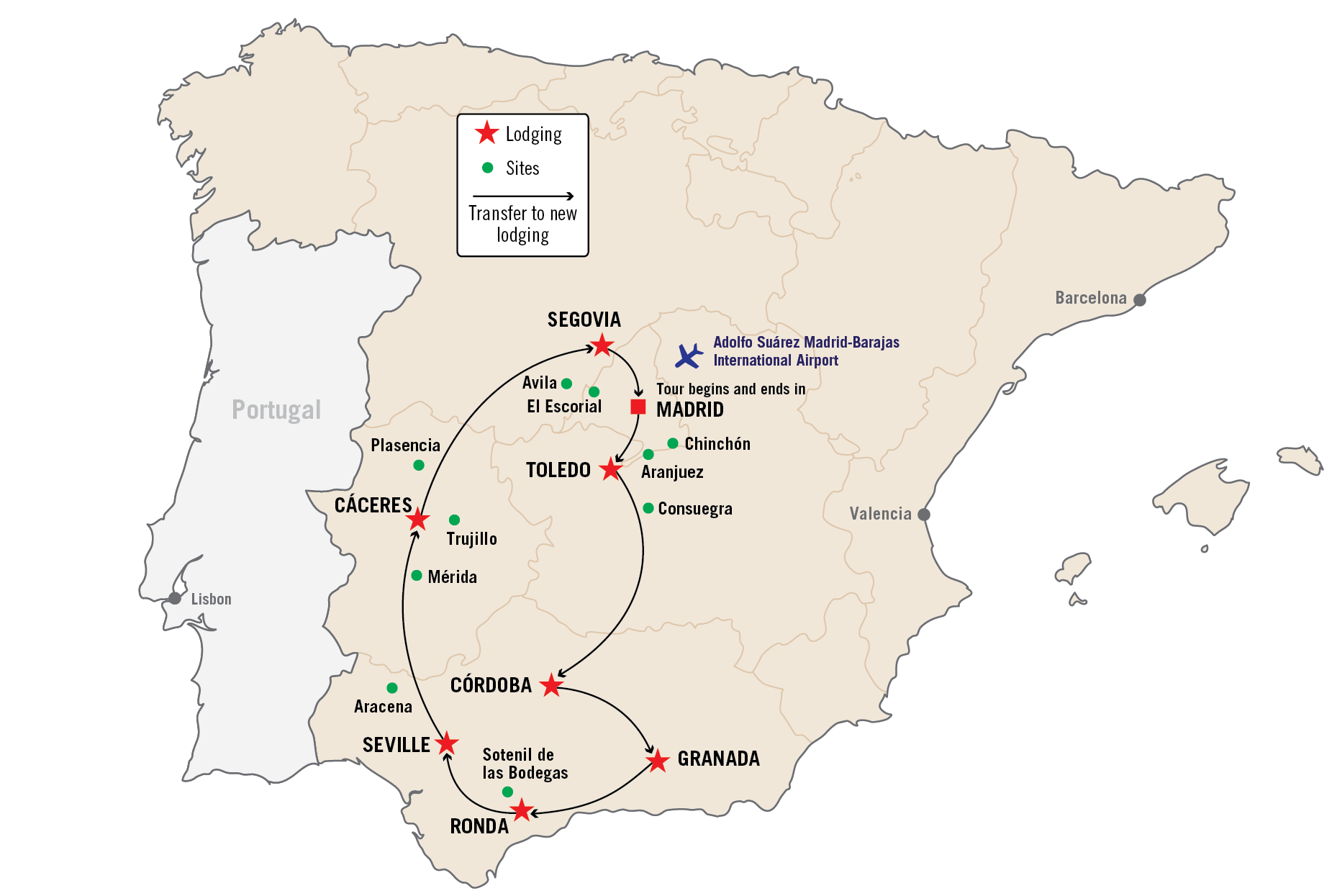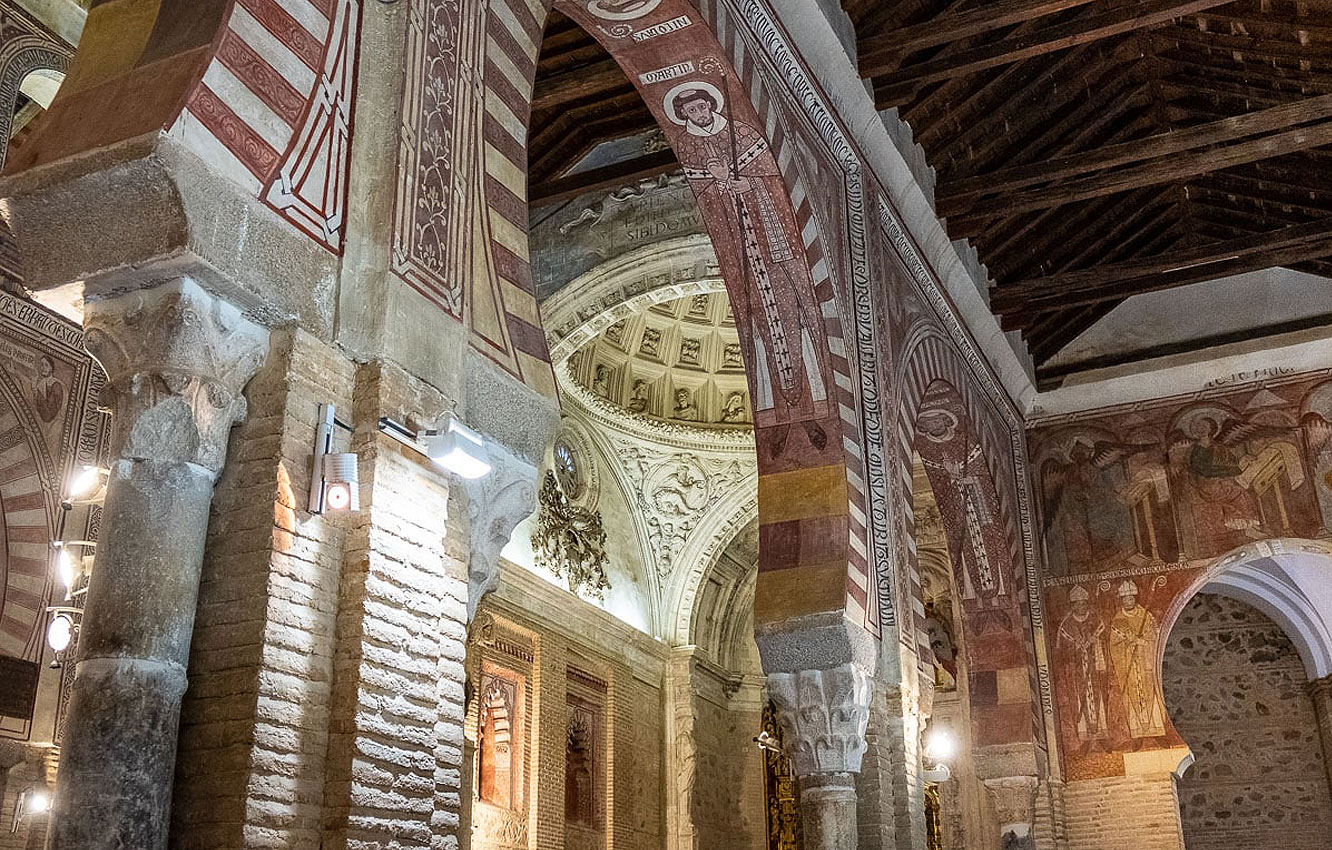~ SPAIN ~
Welcome to Spain, the Journey Begins in Madrid.
Airport pick up.
Hotel check-in (1 night stay).
Options available according to arrival time.
Dinner served at a tapas restaurant nearby the hotel.
Madrid
There are several theories about the etymology of Madrid’s name based on the different settlements, starting with the Celtic’s Magetoritum, then the Romans who called it Matrix and its subsequent Mozarabic variant Matricis, all with references to water, most likely due to its vicinity to the river Manzanares. But the most plausible origin comes from the Arabic word maǧrà (spring) or majrit (fountain). Majrit, romanized as Magerit, is the first documented name of this city. Madrid became the capital of Spain in 1561 and since 1983 is also the capital city of the surrounding autonomous community of Madrid. It's located almost exactly at the geographical heart of the Iberian Peninsula and it is the political, economic and cultural center of the country. Madrid is a multifaceted city of contrasting styles, the old center with a maze of small streets, historic and characteristic neighborhoods and the imposing Plaza Mayor contrasts with the Neoclassical buildings and grand boulevards. Madrid is considered an European capital of the art. Home of museums such as the Prado, the Reina Sofía and the Thyssen-Bornemisza, and historic buildings like the Royal Palace and the convent of the Descalzas Reales, where some of the masterpieces of the famous artists Goya, Velasquez, Titian, Picasso, and many more can be admired.
2nd Leg: Moving to Toledo
City Exploration, Madrid on Foot
Morning
- Walking guided tour:
- Strolling through the winding streets of the medieval center, visiting architectural gems and charming squares like the Plaza Mayor.
- Learning about the fascinating transition from a fortified medieval outpost to the regal capital of a global empire, appreciating Madrid's history and its place in the world.
Afternoon
- Guided tour at Museo del Prado, the main Spanish national art museum with one of the world’s finest collections of European art.
- Drive to Toledo.
Dinner in the historic center.
Plaza Mayor
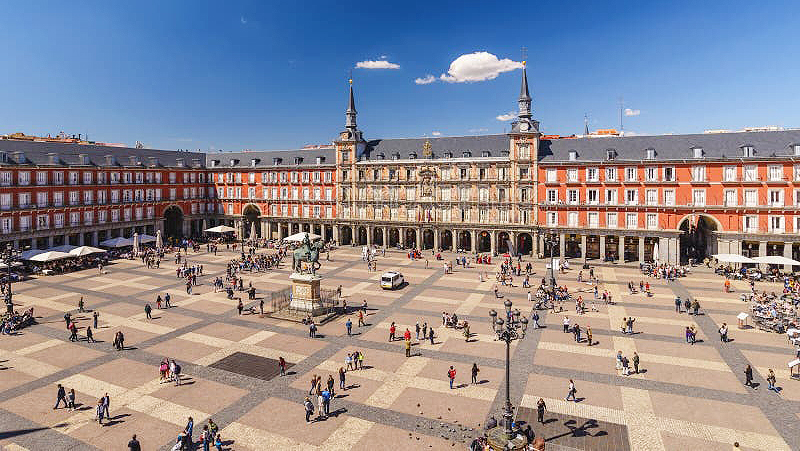
The Plaza Mayor is located in the oldest part of Madrid, designed by architect Juan Gómez de Mora, built in the 16th century to replace the originally called Plaza del Arrabal which was used as the main market of the town and has been rebuilt several times throughout history after a series of fires. It is rectangular in shape and measures 129 m x 94 m (423 ft x 308 ft) with ten entrances and surrounded by three-story buildings with porches all along the plaza. Its main landmarks are the Equestrian statue of Philip III, given as a present by the Duke of Florence to the King of Spain in 1616 and placed in the center of the Plaza only in 1848; the Casa de la Panadería, established in 1590 to served as the most important bakery in Madrid; and the Arco de Cuchilleros, one of the entrances to Plaza Mayor.
Madrid Art Walk
In the heart of Madrid, the Prado, the Thyssen-Bornemisza and the Reina Sofía museums are all located at a short distance from each other.This area, known as the Paseo del Arte de Madrid or Madrid Art Walk, is one of the cultural treasures that motivated UNESCO’s recent decision to declare the Paseo del Prado-Retiro zone a World Heritage Site, named El Paisaje de la Luz (The Landscape of Light). Together, these three of the world’s most important art galleries offer a delightful display of the history of Western art, from the medieval to the contemporary era.
Museo del Prado
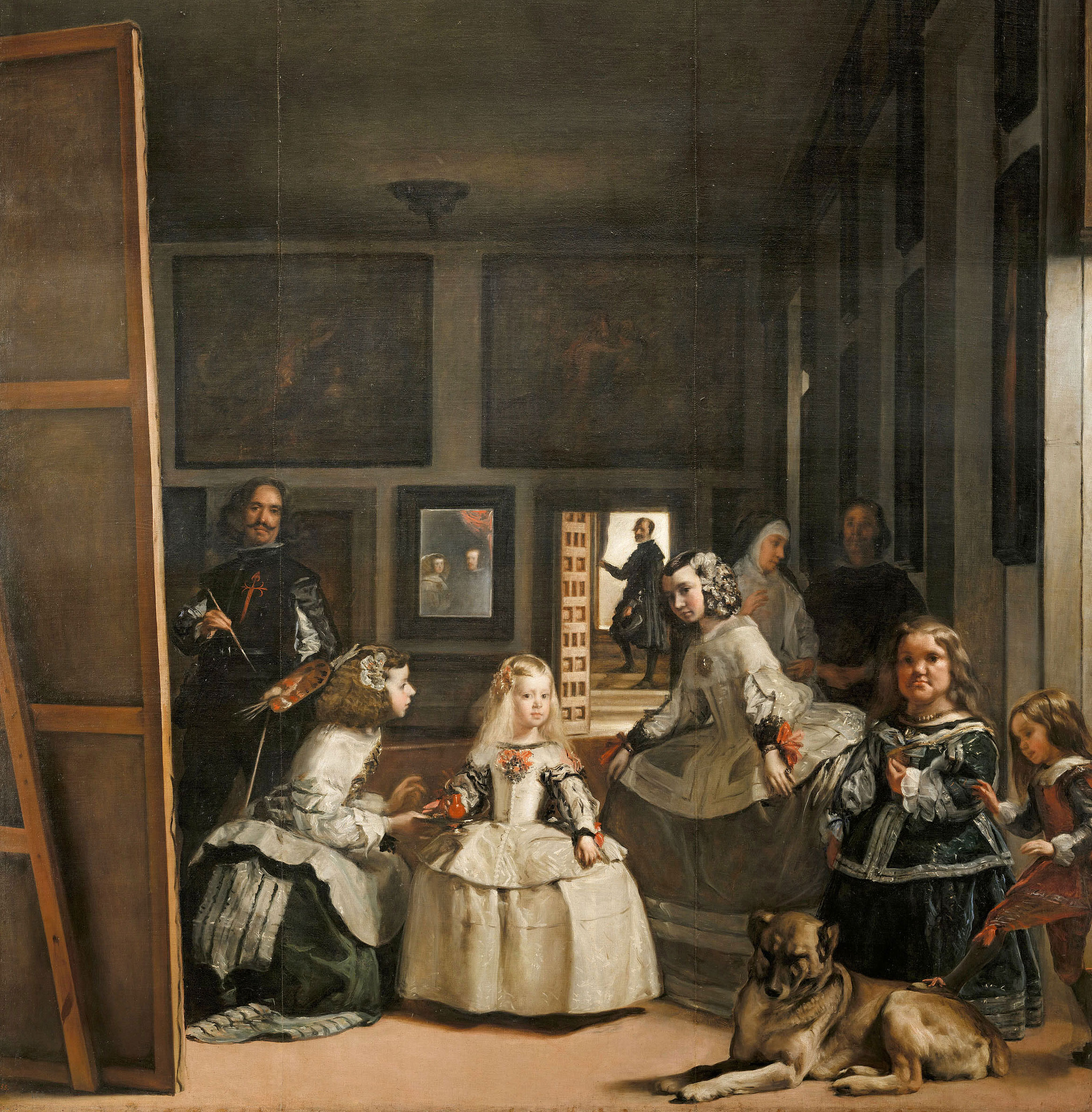
The Prado Museum owes its origins mainly to the tastes of the Spanish monarchs of the 16th and 17th centuries, who aimed to collect as many works as possible of their favorite artists. Due to this unique way of collecting the Prado is described as a museum of painters not of paintings. Artists, such as Bosch, Titian, El Greco, Rubens, Velázquez and Goya, are superlatively represented, some of them with more than 100 works each. Today the museum houses works (approximately 8,200 drawings, 7,600 paintings, 4,800 prints, and 1,000 sculptures) dated from the 12th century to the early 20th century. The Prado has also one of the finest collections of Italian masters outside Italy such as Veronese, Tintoretto, Raphael, Parmigianino and Tiepolo. Photo above: One of the most popular paintings in the museum, Las Meninas by Velázquez, an enigmatic oil on canvas from the 16th century depicting the Spanish royal family and their attendants with the young Princess Margarita as the centerpiece.
The City of Three Cultures
Morning
- Walking guided tour:
Discovering the places that symbolize the coexistence of the Muslim, Christian and Jew cultures:- Catedral Primada, a gothic Cathedral with the inside Treasure-Museum.
- Iglesia de Santo Tomé, the church that houses the famous masterpiece of the El Greco painter: The Burial of the Lord of Orgaz.
- Sinagoga del Tránsito, probably, along with the Cathedral, the most important and beautiful building the city has to offer.
- Monasterio de San Juan de los Reyes, a Franciscan monastery with a spectacular cloister.
Afternoon
- Free Time or:
Art and historical options:- Museo de Santa Cruz, a hospital in the 16th century, was transformed into the Regional Archaeological Museum in 1844 with sections dedicated to Archeology, Fine Arts and Decorative Arts.
- Iglesia de San Román, the only church in town that has kept its original structure since the 13th century, as well as the majority of the Roman frescoes that decorated it. The church also houses the Museum of the Councils and Visigothic Culture.
- Marzipan. Get to know and taste the almond-based confection of muslim origin, which today continues its tradition in Toledo thanks to each and every convent that makes it and sells it throughout the year. One of its most characteristic presentations is an eel rolled-up and decorated with crystallized fruit.
- Acero Toledano (Toledo steel). Visit a workshop where swords are still crafted by hand in the tradition that made the swordsmiths of Toledo garnered fame worldwide thanks to the special technique for tempering the steel blades.
- Damascene. Visit a workshop to learn about the technique of encrusting gold or silver threads into steel objects brought to the Iberian Peninsula by Syrian artists from Damascus (hence its name) which has survived in Toledo as one of its best-known crafts.
Toledo
Once the capital of Spain, Toledo became a UNESCO World Heritage Site in 1986 for its historic center and immense cultural heritage. It is considered to be the most representative example of Spanish culture, a melting pot where Christians, Jews, and Muslims were able to co-exist for several centuries. Toledo, located 70 km (43.5 mi) south of Madrid, sits on a promontory overlooking the plains of Castilla-La Mancha and surrounded on three sides by the river Tagus. It was an important Roman colony, the capital and residence of the Visigothic Kingdom, a fortress of the Emirate of Cordoba, an outpost of the Christians fighting the Moors, and home of an important Mozarab community (Arabic-speaking Christians). Still preserving its original medieval layout, Toledo, with its narrow, cobbled, winding streets and monuments such as the Gothic cathedral, the Alcázar, the Synagogues and Monastery, is one of the most visited cities in Spain. Toledo is known for being home to famous works by the painter El Greco, and also for the production of swords, marzipan and damascene jewelry and hand crafted objects.
Santa Iglesia Catedral Primada
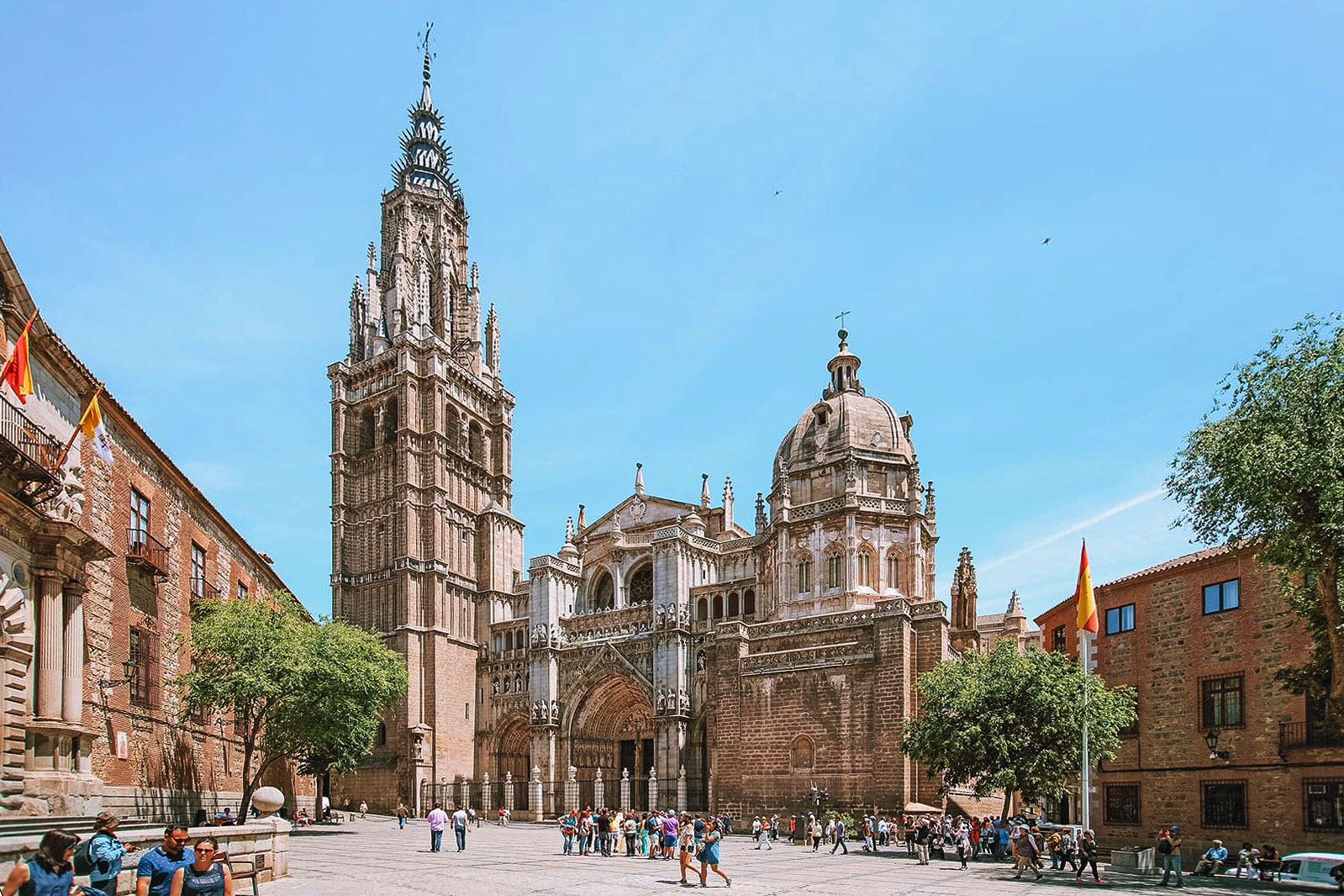
The Primatial Cathedral of Saint Mary, well-known for its magnificent medieval Gothic architecture, as well as for the famous artwork inside, dates back many centuries and its construction took about 270 years. Its history is long and complex. It was actually built on top of a Muslim mosque, and before that, in the 6th century, it had been a church during the reign of the Visigoths. The actual Cathedral was built in the 13th century and has been modified several times over the centuries. It has 5 naves and measures 120 m (390 ft) long, 59 m (194 ft) wide and 45 m (147 ft) high. The roof is supported by 88 columns and 72 vaults. The polychromatic stained glass windows date back to the 14th, 15th and 16th centuries. Inside the Cathedral there are several interesting areas, such as the Sacristy, the Choir and the Capitulary Room, with remarkable pieces of art.
Iglesia de Santo Tomé

The Church of Santo Tomé was built in the 13th century on the same site where a mosque had already stood in the 11th century. It went through Mudéjar-style reforms in the 14th century, paid for by the Lord of Orgaz, benefactor of the parish, as well as in baroque style in the 17th century, which changed its interior. The tower, in Mudéjar style, is one of the most beautiful in the city and showcases all kinds of decorations in the Muslim tradition, such as horseshoe, multifoil and interlacing arches. The church houses El Greco’s most important piece of work El Entierro del Conde Orgaz (The Burial of the Lord of Orgaz) that depicts the descent of two saints from heaven, Saint Augustine and Saint Stephen, to bury their “favored son”, the Lord of Orgaz, for leading an exemplary life.
Sinagoga Del Tránsito
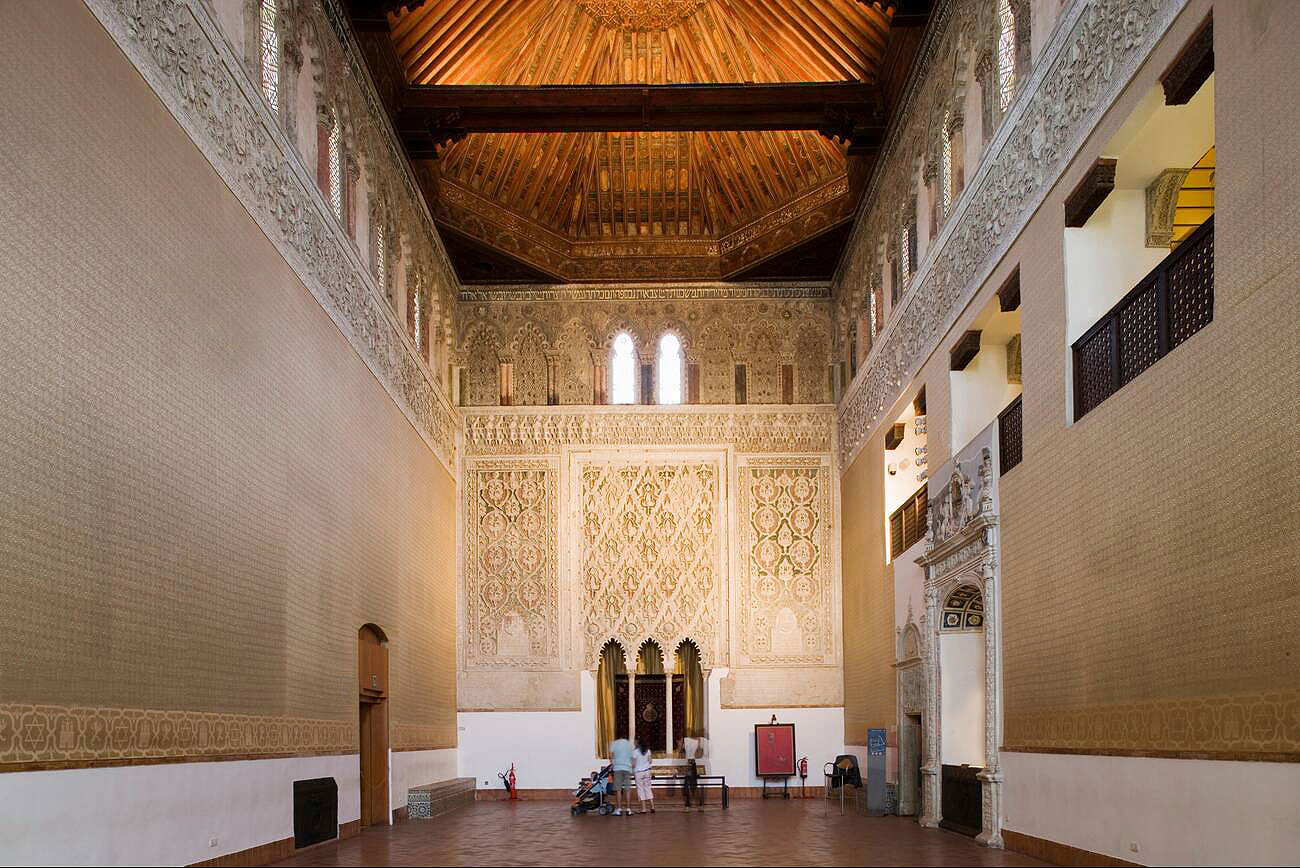
A glowing testament of the Sephardic community, this is one of the only two synagogues still standing out of the twelve that existed in Toledo in medieval times. It represents the most exquisite example of Mudéjar art, where the plasterwork, ceramics and ceilings were crafted by Muslims and Christians to meld with Jewish customs, a fine expression of the religious coexistence experienced for more than six hundred years in Toledo. The true importance of the monument lies not only in its grand dimensions, but also in the beauty of its interior covered with all kinds of carvings: fruit and floral decorations, geometric patterns as well as inscriptions of Jewish sacred texts in Hebrew; all painted in greens, reds, black, blues and white. Worth mentioning is the spectacular wooden ceiling framework in Mudéjar-style, highlighting geometric elements decorated with lattice-patterned tracery in the central part.
Monasterio de San Juan de los Reyes
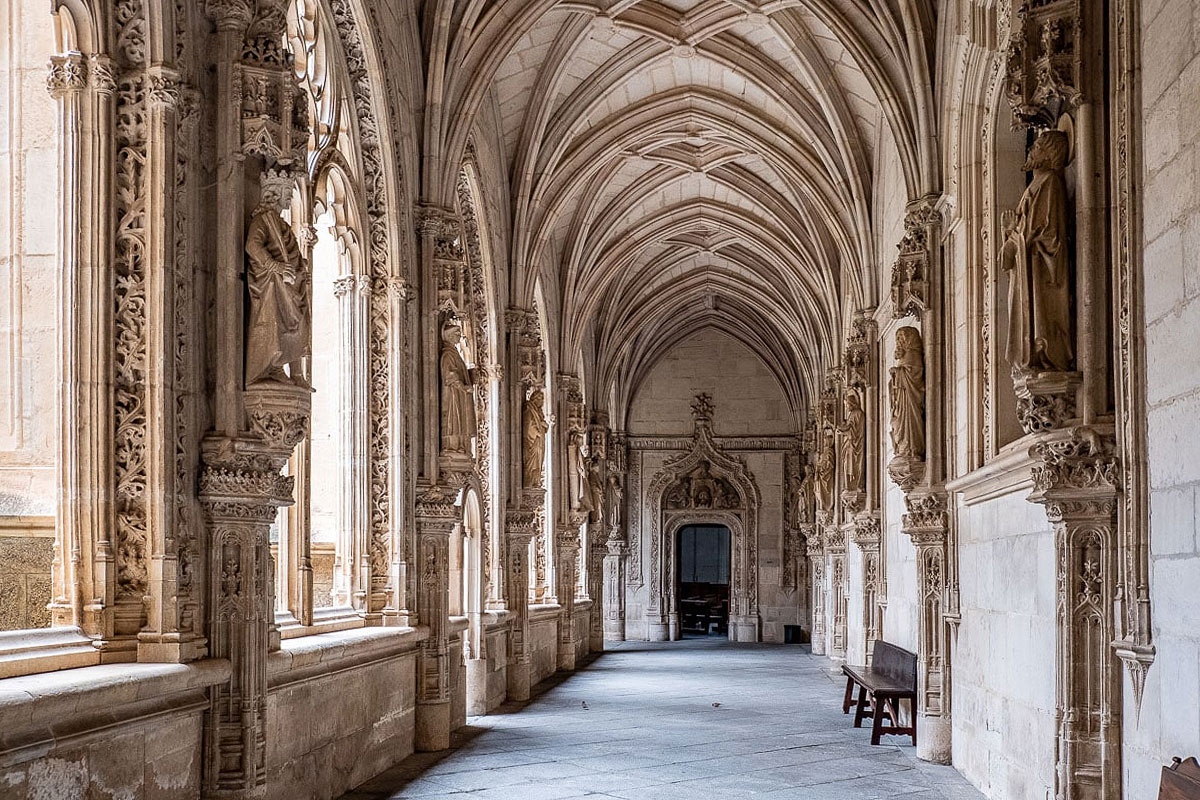
The Monastery of San Juan de los Reyes, built deliberately in the heart of the Jewish quarter of Toledo, is an Isabelline style Franciscan monastery commissioned by the Catholic Monarchs Ferdinand II of Aragón and Isabel I of Castile. The construction began in 1477 and was completed in 1504, dedicated to Saint John the Evangelist for use by the Franciscan order. It was badly damaged in 1809 by Napoleon's troops during their occupation of Toledo and later abandoned in 1835. The restoration of the monastery began in 1883 which lasted until 1967. The highlight of the monastery is the remarkable two-level cloister and its small garden. The ceiling on the ground floor is formed of late Gothic German cross vaults that harmoniously integrate with the Mudéjar elements of the upper cloisters.
Art and Cultural Traditions
The Royal Palace
Morning
- Drive to Aranjuez, one of the Royal Estates of the Crown of Spain in 1560. Until 1752, only royalty and nobility were allowed to dwell in the town.
- Guided tour to the Palacio Real, one of the official residences of the Spanish royal family with beautiful extensive gardens and nice fountains.
- Drive to Chinchón to visit its picturesque square.
Afternoon
- Drive back to Toledo.
- Free time or optional activities listed on the previous day (DAY 3).
Palacio Real de Aranjuez
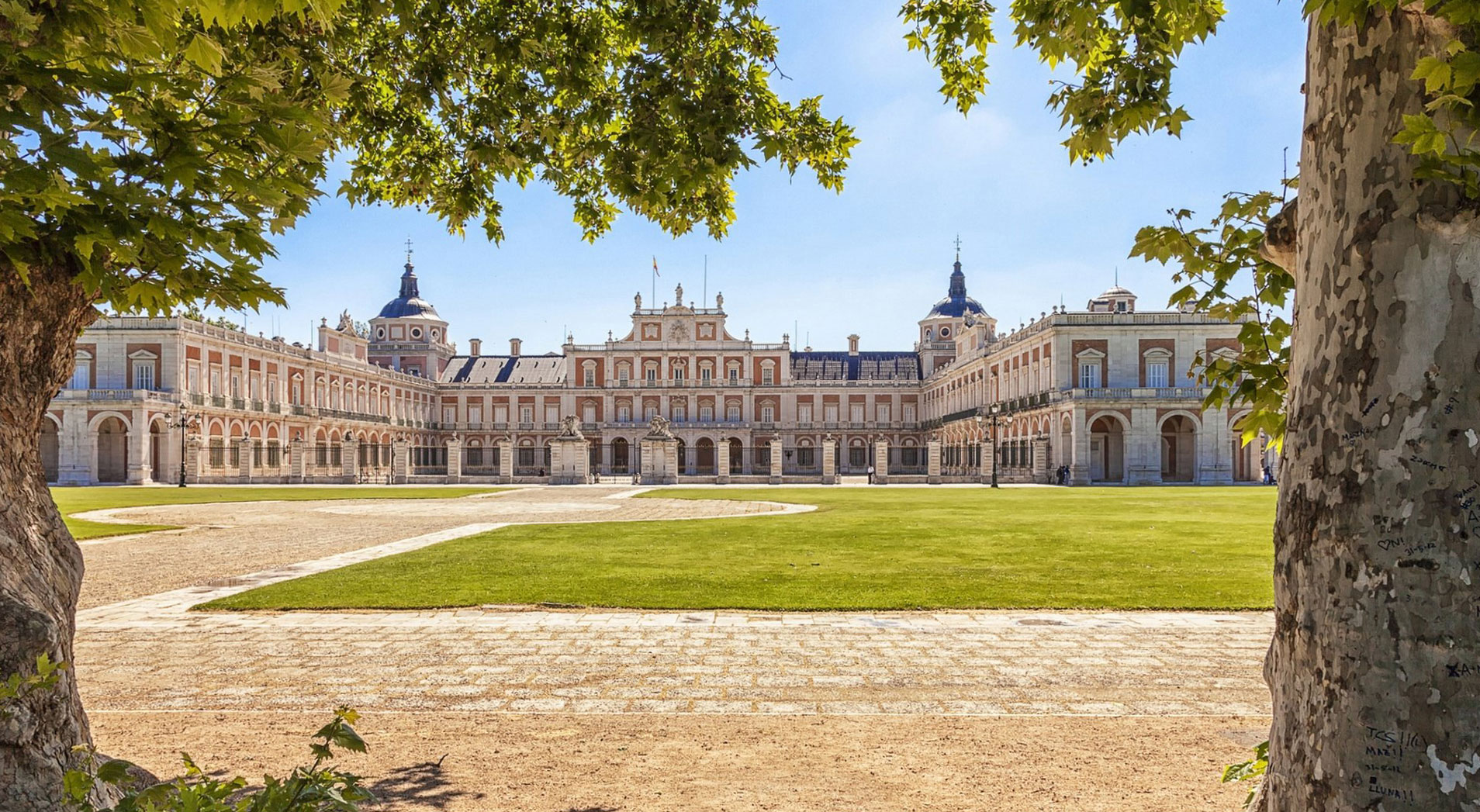
The Palace project was commissioned to the architect Juan Bautista de Toledo and later to Juan de Herrera where he began his architectural career. Herrera was also the architect of the well known monastery El Escorial and gave name to the homonymous Herrerian style which characterized the Spanish architecture style of the 16th century. The very well preserved Royal Palace of Aranjuez, once established as a hunting lodge, is one of the official residences of the Spanish royal family. In 1775, twenty years after the project was completed, Carlos III commissioned Francesco Sabatini to add two wings giving the Palace its current U shape. In 1931 the Palace with its rooms and halls, filled with history and beauty and 111 hectares (275 acres) of visitable gardens, opened its doors to the public and became the Aranjuez Cultural Landscape, a Unesco World Heritage Site.
Chinchón
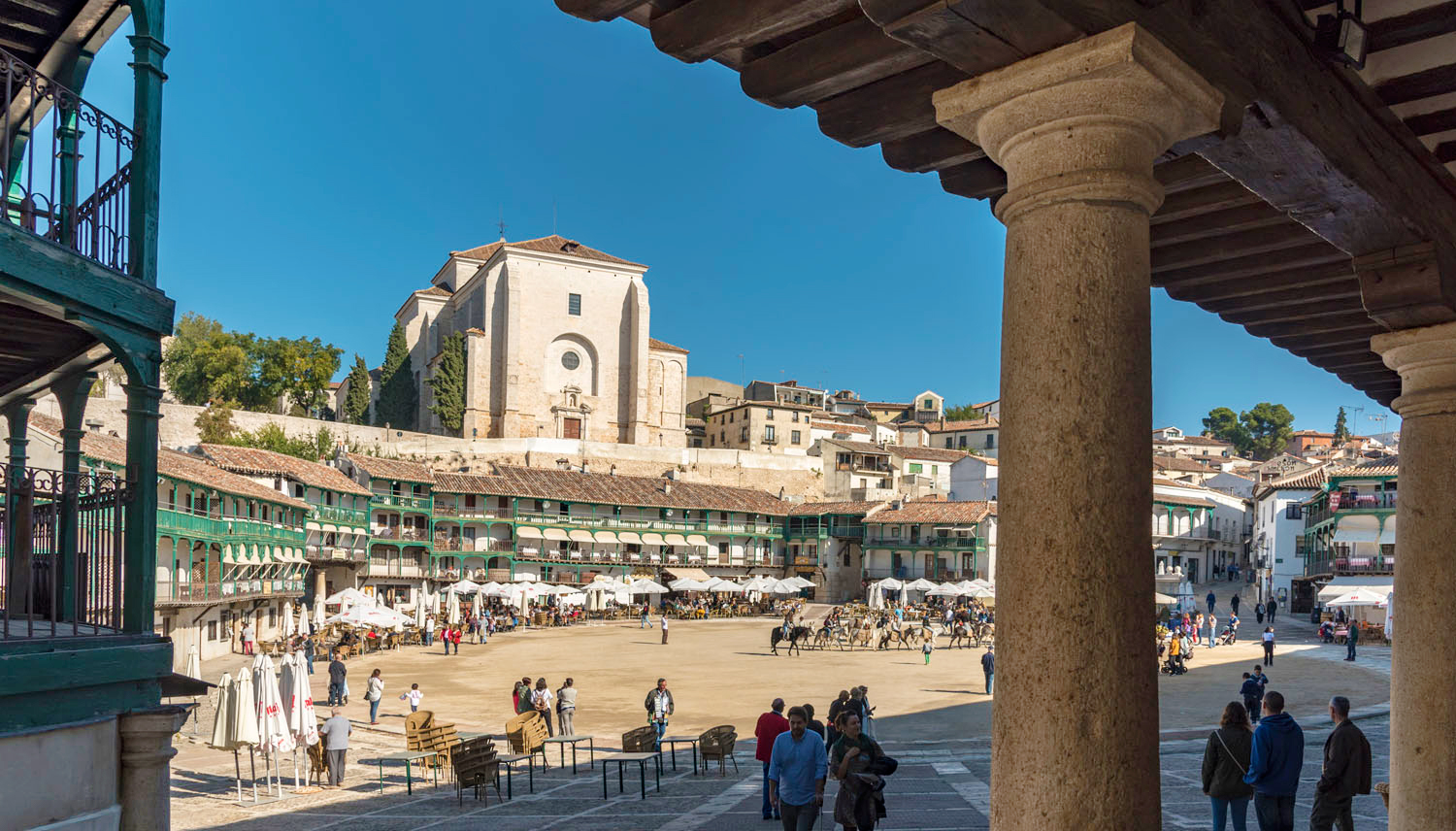
Chinchón is located 70 km (44 mi) north-east of Toledo and sits on a hilltop surrounded by vineyards and olive groves. The most interesting and emblematic place in Chinchón is the Plaza Mayor, an irregularly shaped medieval square, a fine example of Castile’s traditional architecture. The square is circled by buildings with arcades and 234 green wood balconies, called claros, supported by upright wooden pillars. Is an iconic square that, through history, has hosted royal announcements and celebrations, bullfights, livestock fairs and film shootings with well known actors, such as Rita Hayworth, Orson Welles and John Wayne. During the War of Independence, the Napoleonic troops sacked and damaged various buildings, including the church of Nuestra Señora de la Asunción which was later restored and today houses a precious painting by Goya commissioned by his brother, then the chaplain of the church.
3rd Leg: Moving to Córdoba
In a Place of La Mancha...
Morning
- Meet at 9:00 to leave for Córdoba.
- Stop to visit the Molinos de Consuegra. The windmills, symbol of La Mancha, crown the Calderico hill for an amazing unique landscape of one of the largest and best preserved mill complexes in Spain.
Afternoon
- Drive to Córdoba.
- Flower tasting. Learn about the great variety of flavors offered by the flower petals which, for example, depending on how they are consumed or combined, add acidity or leave a sweet aftertaste in the mouth.
Molinos de Viento de Consuegra
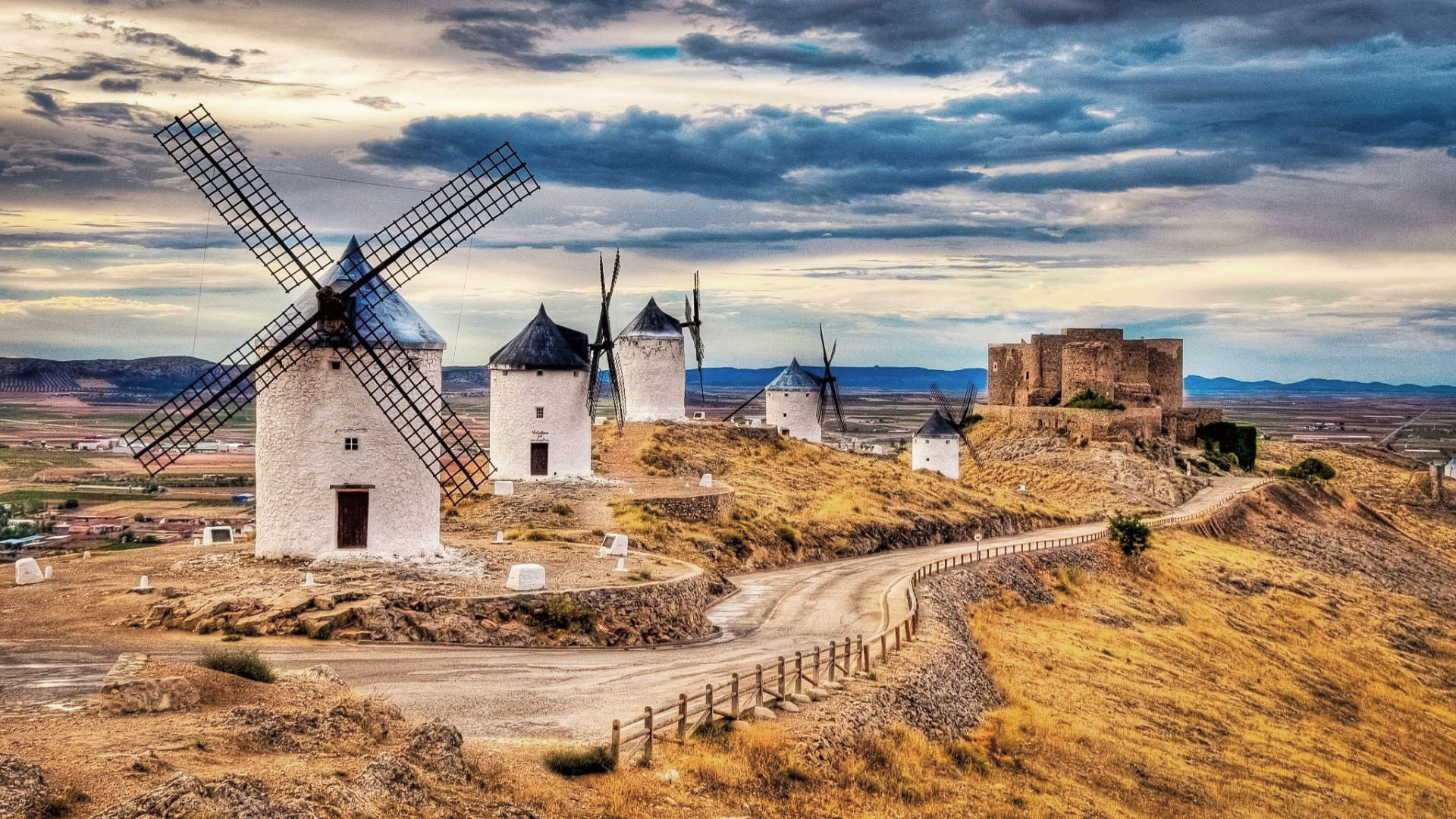
Famous thanks to Cervantes who, knowing the area well, wanted to capture them in his novel Don Quixote. Nestled at the top of the hill to take better advantage of the air currents provided by the elevations, these twelve giants have watched over the history of Consuegra and its people during centuries. Some dating back to the 16th century, they have been absolutely vital and essential for the development of the region, since the absence of constant water currents (La Mancha comes from Arabic and can have a similar translation to “dry land”) prevented the establishment of fluvial mills. Of the thirteen mills that originally existed, 12 have been restored and can be enjoyed today. Each one with its own name, some dedicated to La Mancha themes, while others evoke chapters from Don Quixote.
Flower Tasting
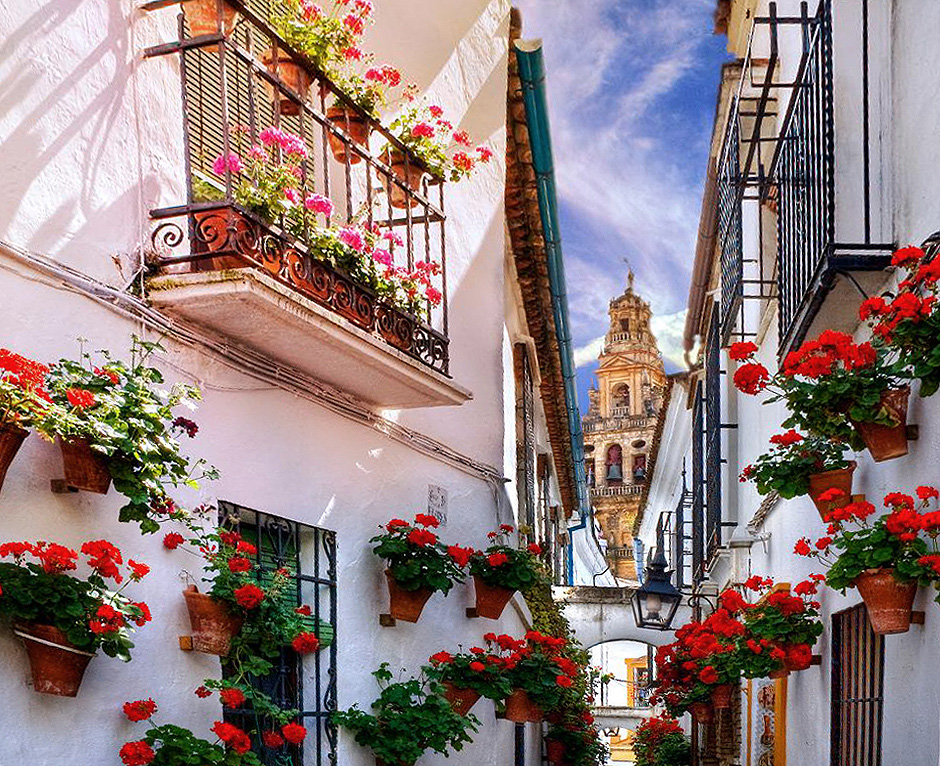
Córdoba becomes, for a few days in May, a festival of colors that never ceases to amaze. This period is known as the Flower Festival due to the large number of plants and flowers that grace the streets of the city. Córdoba is transformed into a paradise of flower fragrances and colors in which owners of the patios compete to have the most beautiful one and open their houses to tourists. This event has been listed as an Intangible Cultural Heritage of Humanity since 2012 by UNESCO. The focus of the Flower Festival is to enjoy the beautiful views that flowers create throughout the city. In the neighborhood of San Basilio it is possible to participate in a flower tasting to sample the flowers of the patios, specifically, those of the Patio de la Muralla, which carries out an activity called floral alchemy to taste edible flowers as well as watching an exclusive live distillation of a blend of flowers and a visit to the area's patios.
Founded by the Romans Ruled by the Arabs
Morning
- Walking guided tour in the historic center:
- Mezquita-Catedral, an elegant mosque with 850 columns, one of the great wonders of the western Muslim World, now a Christian cathedral.
- Alcázar de los Reyes Cristianos, a medieval fortress once served as residence for the Christian monarchs. Inside, the beautiful 13 acres of gardens are laid on three clearly differentiated terraces with several elegant fountains and ponds.
Afternoon
- Free time or optional activities:
- Palacio de Viana, a renaissance palace with tranquil courtyards, a formal garden and an art and antiques collection.
- Torre De Calahorra. The tower is located at the southern end of the Roman bridge and was built as a defensive fortress. From its terrace, the view over the city, the river and the bridge is impressive.
- Roman Temple, discovered in the 1950s during the expansion of the City Hall.
- Drive to Madinat al-Zahra or Medina Azahara, a fortified palace-city on the western outskirts of the city.
Córdoba
Córdoba is located on the banks of the Guadalquivir river and at the foot of the Sierra Morena. It was a Roman settlement during the 2nd century BC and became the capital of Later Hispania during the Roman Empire. Its peak began in the 8th century during the Muslim domination, when some 300 mosques, palaces and public sites were built to rival the splendors of Constantinople, Damascus and Baghdad. It rose as the capital of the Emirate of Córdoba, becoming the most inhabited, cultured and opulent city in Europe, as well as a leading center of education. During the Middle Ages, art and science flourished in Córdoba, laying the foundations for the European Renaissance. Mosques, libraries and baths abounded, in addition to having a multitude of beautiful tiled fountains. A notable example of Moorish architecture is the Mezquita-Catedral that was included in the renowned Unesco World Heritage list in 1984.
Mezquita-Catedral
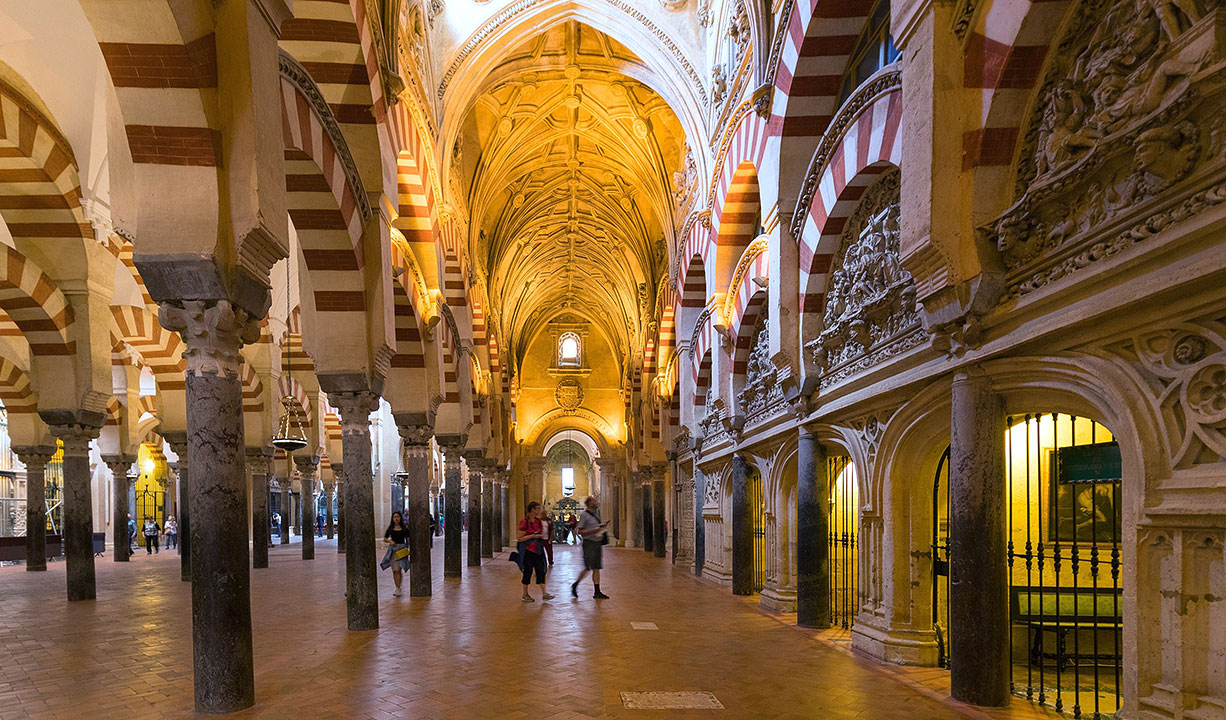
The Great Mosque of Córdoba is one of the oldest buildings still standing from the time Muslims ruled Al-Andalus in the late 8th century. When the Moors invaded Andalusia in 711, the original christian Visigoth church was divided in two and used by both Muslims and Christians. In 784, the Emir Abd al-Rahman ordered that the church be destroyed and the construction of a great mosque started which lasted over two centuries. In 987 the building was completed to become the second largest in the Islamic kingdom. The mosque consists of a large prayer hall filled with columns, a courtyard with a fountain in the middle, an orange grove, a covered walkway circling the courtyard, and a minaret, now encased in a squared, tapered bell tower. The remarkable prayer hall seems magnified by its repeated geometry and a striking combination of two-tiered, symmetrical arches, formed of stone and red brick.
Alcázar de los Reyes Cristianos
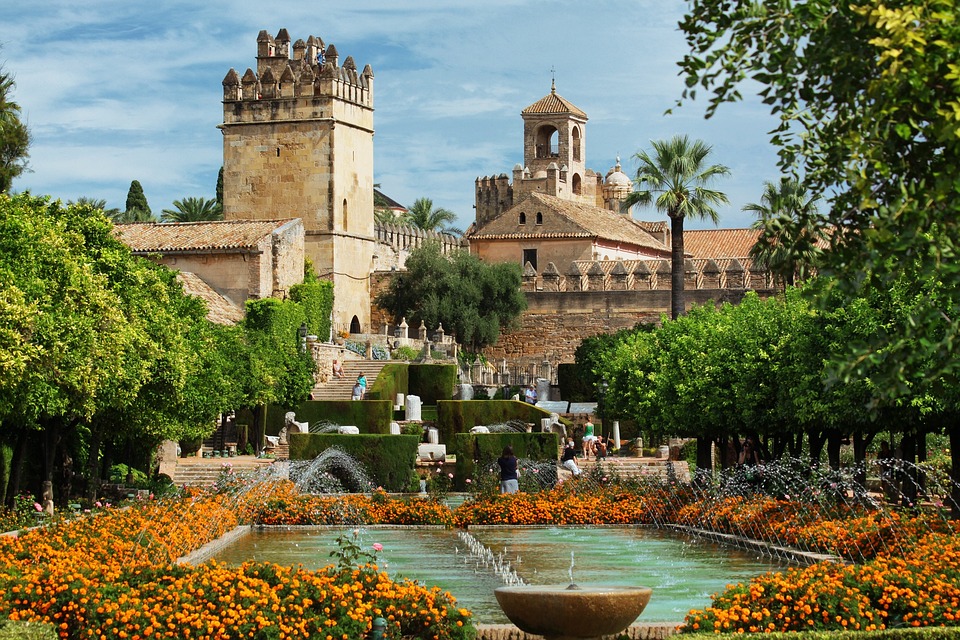
The Alcázar of the Christian Monarchs is a fortress and palace, a fine example of Cordoban architectural evolution. Roman, Visigothic and Arab remains coexist in this majestic site, a favorite place of the different rulers of the city. In Roman times it had the character of a fortress, benefiting from its privileged location, and in the period of the Muslim presence it was part of the group of buildings that made up the Umayyad fortress. Throughout its history it has performed very diverse functions: In the Middle Ages was a royal residence, in the Modern Age it was the headquarters of the Inquisition, and from 1822 to 1931 it was a prison. The Alcázar forms an almost square enclosure with its vertices protected by towers. The current building was ordered by Alfonso XI in 1328 who wanted to create a perfect architectural unit that would refer to European Gothic art in a city that for centuries had been subject to Muslim power, creating a castle-palace antagonistic to the nearby Mosque.
4th Leg: Moving to Granada
Wine and Olive Oil
Morning
- Meet at 10:30 to leave for Granada.
- Stop to visit a family owned winery in the Sierra de Montilla, where the artisanal production of wines and oils has been handed down from generation to generation.
Afternoon
- Drive to Granada.
- Free time or optional activities:
- Shopping at the Alcaicería, an old silk market area where currently craft shops and Arab bazaars coexist. Here it is possible to feel the essence of the Arab legacy and the bustle of its souks where it is still practiced the art of bargaining.
- Catedral and Capilla Real. Situated side by side, the Cathedral and the Royal Chapel together make an impressive monument to the power of the Christian monarchs in Andalusia. The Cathedral houses paintings by Ribera and El Greco and the chapel shrine contains the remains of Isabella of Castile and Ferdinand of Aragón.
- Time to do some washing at a laundromat.
- Aperitif and Flamenco show.
Granada
Granada is a compelling city rich in history and culture and one of the most interesting cities in Andalusia, situated at the foot of the Sierra Nevada mountains, was established as one of the main cities of Al-Andalus during the Moorish conquest in 711 that brought Islamic rule to the Iberian Peninsula. It prospered and grew quickly and by 1236 the city became the capital of the Emirate of Granada, as the heart of a powerful and self-sufficient kingdom with the construction of the royal palace and fortress, the Alhambra. Following a military campaign led by King Ferdinand II of Aragón and Queen Isabella I of Castile, without the Alhambra itself being attacked, Granada was the last stronghold of the Spanish Moors to fall to the Christians in 1492 who forced the Jewish and Muslim population to convert and began making changes like replacing the city's primary mosque with the Cathedral in an attempt to vanish its Muslim legacy. Granada remained a largely medieval-style city well into the 19th century and retains an unmistakably Moorish flavor present in its Islamic architecture, gastronomy, craftwork, fountains and houses surrounded by typical gardens.
Catedral

Like many other churches in Andalusia, the Cathedral was built on the site of the city's main mosque after the Christian reconquest of Granada. Planned according to gothic design, the construction began in 1523, but most of the work was carried on later, when the Spanish Renaissance style supplanted the gothic architectural style. Of major interest are the interior gallery (triforium), the choir and the statues of the Catholic monarchs by Pedro de Mena. In the presbyterium area, the Capilla Mayor (main chapel) is encircled by a series of beautiful corinthian columns, while the vault houses a series of delicate stained glass windows. During the 181 years of construction of the Cathedral, several Spanish and Italian architects supervised the work.
Capilla Real
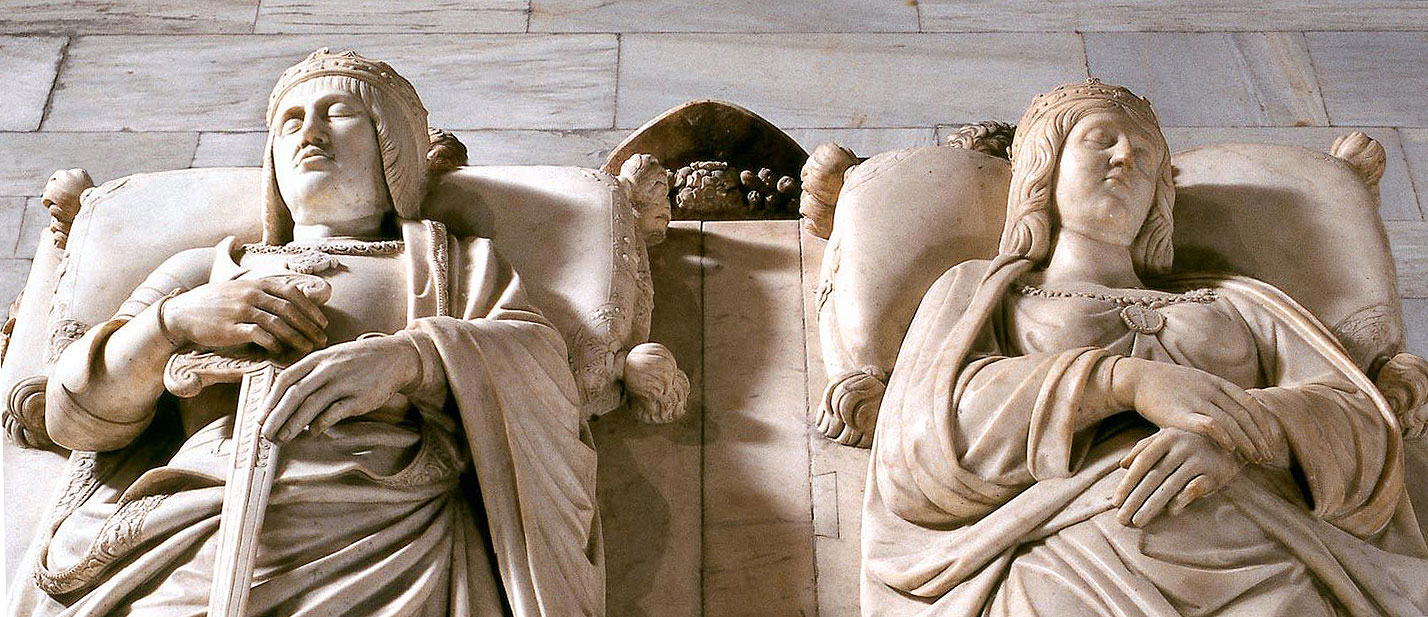
The Royal Chapel is the most important Christian monument of Granada. Built by the architect Enrique Egas between 1505 and 1517 in the late gothic Isabeline style and designed to form part of the Cathedral, the Chapel is the mausoleum of Queen Isabel of Castile and King Ferdinand II of Aragón. The central element is their impressive marble tomb, work by the Florentine sculptor Domenico Fancelli. Under the reigns of Ferdinand and then of Charles V, the Habsburg emperor, the Royal Chapel reached its greatest splendor with its most notable elements, the main altar, the cast-iron choir screen and the crypt, while the sacristy-museum houses a gallery of paintings of the Flemish, Italian and Spanish schools, by important artists such as Hans Memling and Sandro Botticelli. Since its founding, the Royal Chapel has had master composers in charge of the music for liturgical functions.
Flamenco
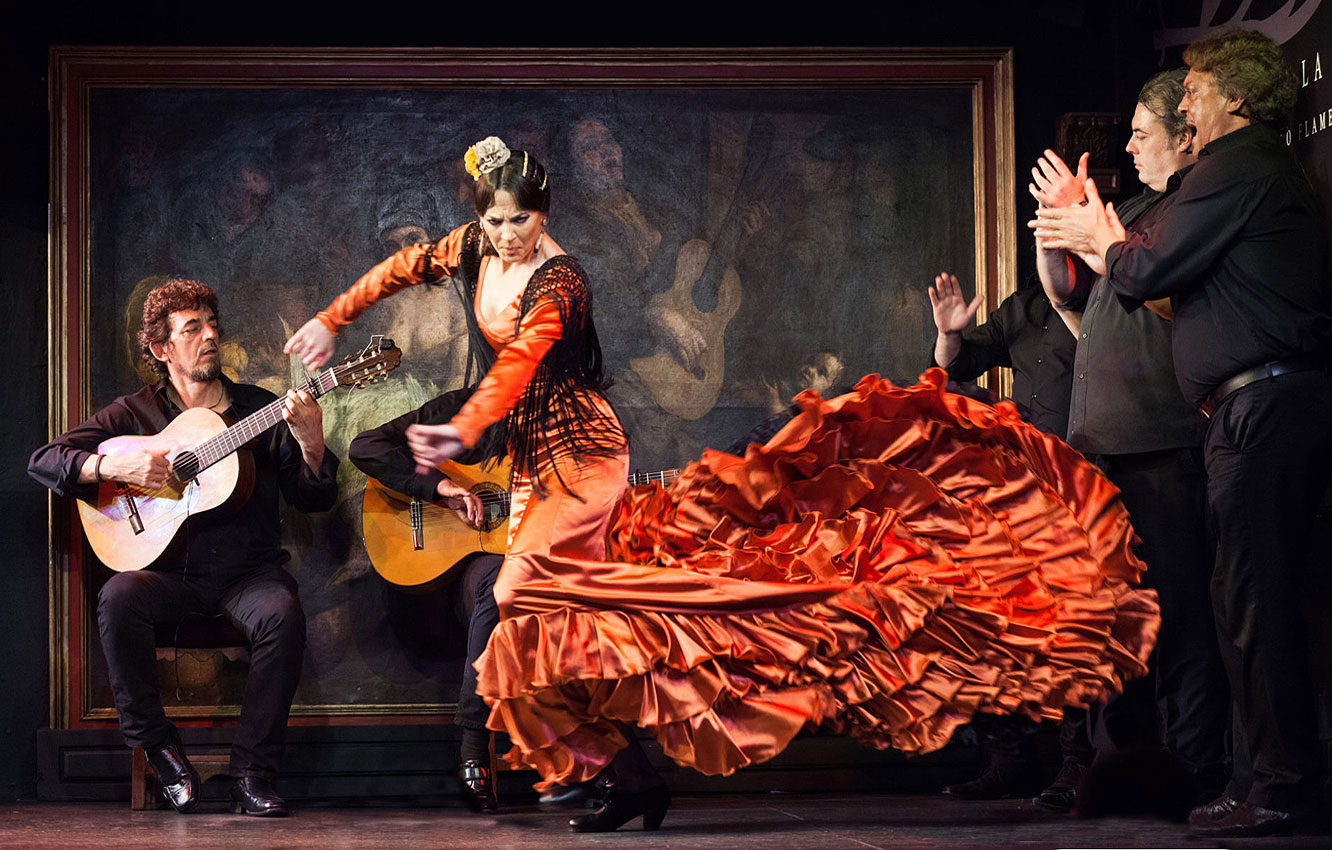
Flamenco, the art form that fuses cante (song), baile (dance) and toque (musicianship) has been inscribed on the List of the Masterpieces of the Oral and Intangible Heritage of Humanity in 2010 by UNESCO. Originated from the various folkloric music traditions of southern regions of Spain, developed within the gitano subculture of the Andalusia region (Seville, Córdoba, Huelva) with deep connections to the gypsy culture. Originally flamenco dancing was not set to music; it was only singing and clapping of hands. Some flamenco dancing still follows ancient tradition, but the use of guitars and other musical instruments has become more popular in modern flamenco. Flamenco is a dance of passion, courtship, expressing a wide range of emotions, from sadness to joy.
The Splendor of the Nasrid Era
Morning
- Guided tour of the Alhambra, an ancient palace, fortress and citadel, a beautiful complex of buildings and gardens.
Afternoon
- Visit Albaicín, the oldest, and by far, the most beautiful part of Granada. Located at the edge of the Alhambra, this is a neighborhood to explore slowly through its narrow streets, small corners and scents from the many gardens enjoying the spectacular views from its terraces and miradores.
- El Bañuelo, one of the best-preserved public Muslim baths in Spain.
- Mirador de San Nicolás, the lookout that offers one of the best panoramic views of Granada, famous for the charm of its surroundings, its cobbled streets, white houses, tapas bars, and its people.
Alhambra
The Alhambra is a monumental complex that consists of a group of old palaces, gardens and fortresses originally conceived to house the emir and the court of the Arab Nasrid kingdom in the 13th century. During this period it was a self-contained city with the essential Muslim sites such as a Friday mosque, public baths, artisan workshops, a tannery, and a sophisticated water supply system. There were at least six major palaces, most of them located along the northern edge where they commanded views over the Albaicín quarter. The palaces follow the traditional Moorish architecture with the courtyard as a central space and basic unit around which other halls and rooms were organized. These courtyards typically had water features at their center, such as a reflective pool or a fountain. Decoration was focused on the inside of the building and was executed primarily with tile mosaics on lower walls and carved stucco on the upper walls. Geometric patterns, vegetal motifs, and Arabic inscriptions were the main types of decorative motifs.
Albaicín
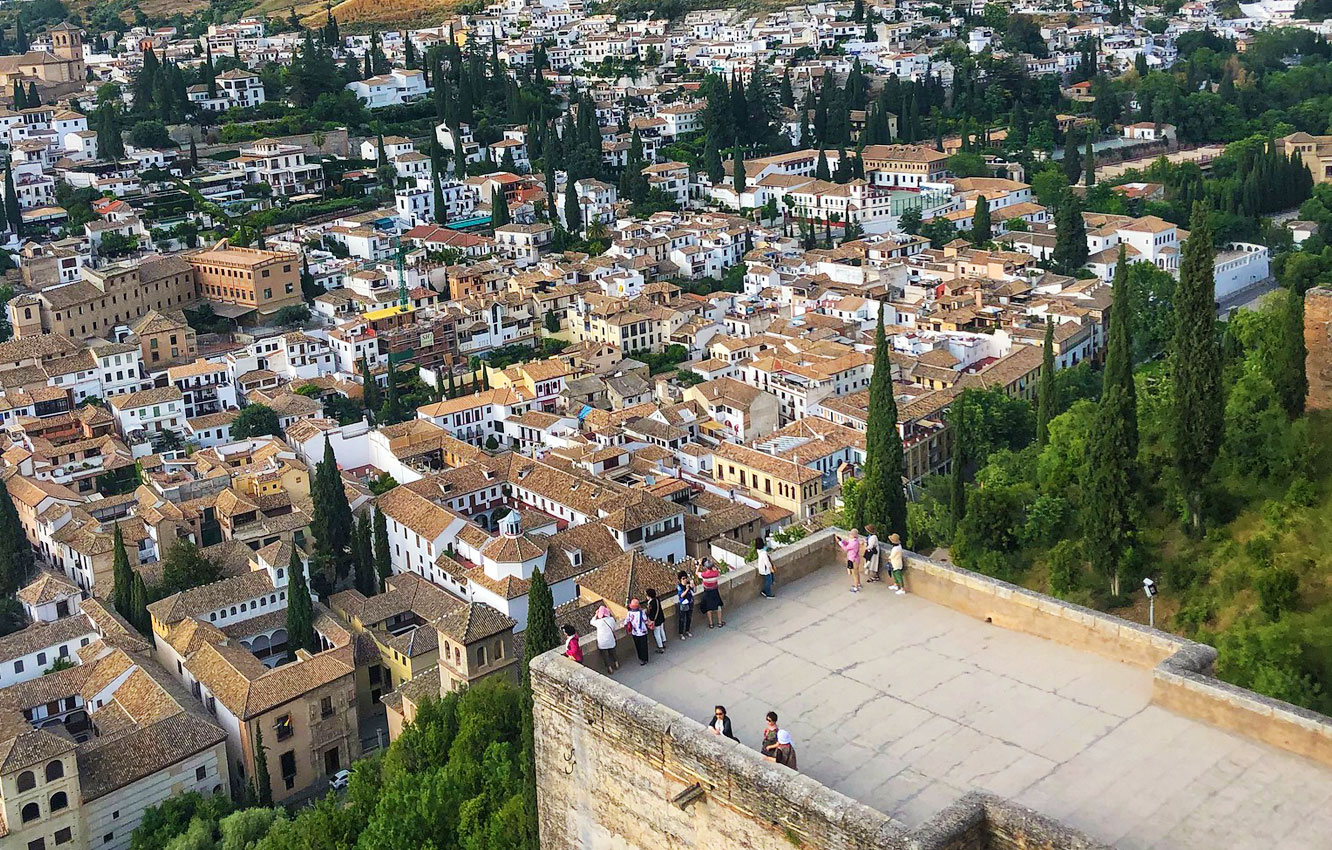
Albaicín or Albayzín, a World Heritage Site, is a neighborhood in the east of Granada that for many centuries was an important cultural center under Islamic and Christian rulers. It is notable for its historic houses or carmens, the cisterns which provided water to the city, the Moorish palace monuments and for retaining its medieval street plan dating back to the Nasrid period even though it went through many physical and demographic changes after the end of the Reconquista in 1492. Its main sites are Casa de Zafra, a traditional house, and the Dar al-Horra, a Nasrid palace built in the 15th century. Both have large rectangular courtyards oriented in a north-south direction. The main rooms of the houses were located behind porticos on the north and south sides of the courtyard with larger rooms in the north to take advantage of the northern winds and the midday sun.
El Bañuelo
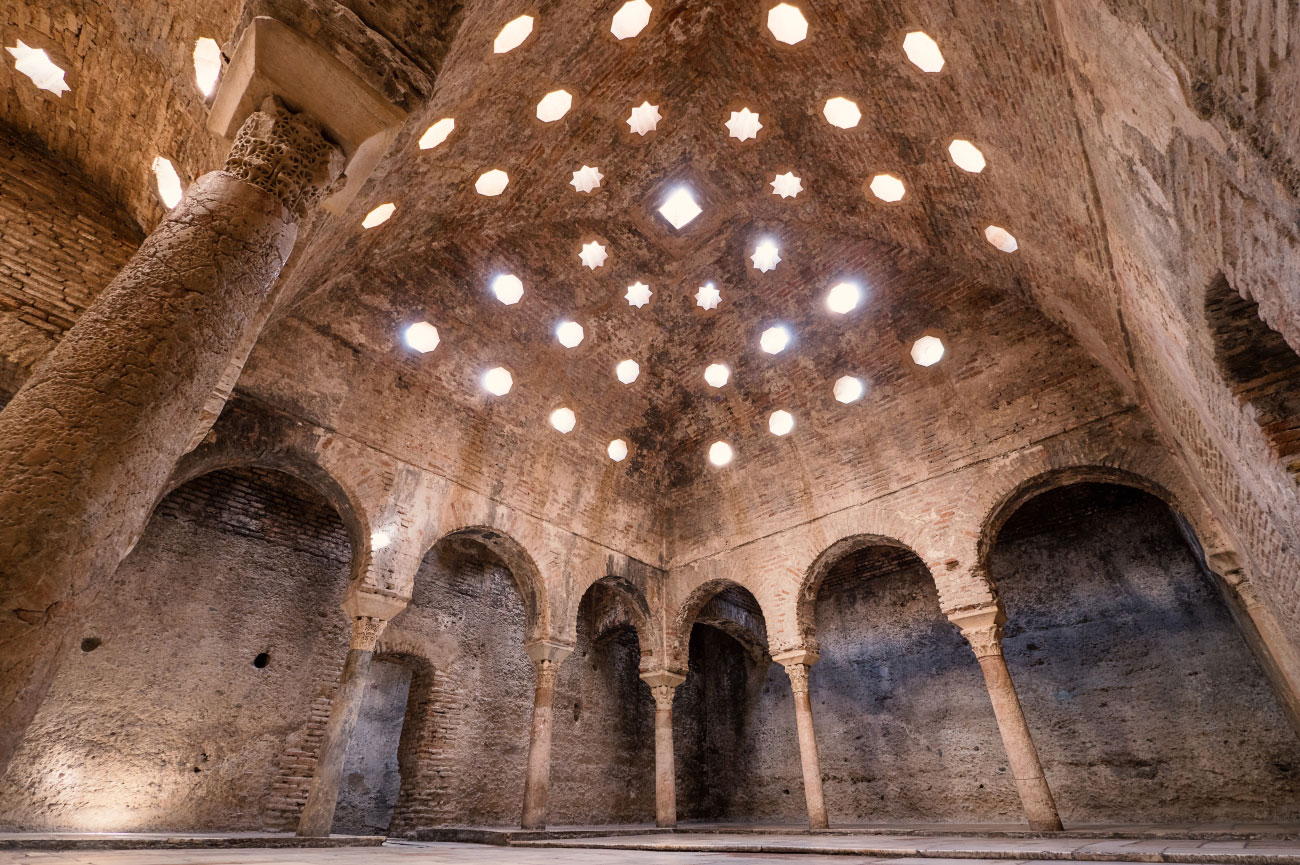
Built in the 12th century under the reign of sultan Badis Ibn Habus, El Bañuelo is the most ancient and better preserved hammam (Muslim public bath) of Spain. Like all the Muslim hammams, it was not only a place of relaxation and social encounter, but also a place of spiritual purification. According to a source, its construction was promoted and financed by the Jewish vizier Samuel Ibn Nagrillah, a poet and philosopher. The area is divided into different rooms to form the classic model of the Muslim hammam. A small vestibule gave access to the refreshing temperature of the cold room; then the bathers moved to the big central room (the Latin tepidarium) under a spectacular dome. The ceilings of the dome are pierced with octagonal skylights that filter the sunrays, creating a magical atmosphere. The service area of the baths housed the furnace that provided hot water and hot air for the third room. Here, through perspiration and ablutions, the bathers concluded the ritual of physical and spiritual purification.
5th Leg: Moving to Ronda
Ronda, a Gem Not to Be Missed
Morning
- Drive to Ronda, a scenic treasure with its narrow streets, bridges, houses on the edge of the canyon and outstanding view points.
Lunch in the central square in the old town area where it is believed the Roman Forum was originally located.
Afternoon
- Free time or optional activities:
- Stroll through the historic quarter with its narrow cobbled streets and view buildings such as the Palacio de Mondragón and Casa del Gigante (Giant’s house), both of Moorish origin.
- Puente Nuevo, a 98 m (321 ft) high bridge, the most emblematic spot in Ronda with the spectacular views of the gorge.
- Plaza de Toros (bullring), one of the oldest and grandest in Spain, and which aroused the interest of people such as Orson Wells and Ernest Hemingway. Inside it, there is the Bullfighting Museum and the collection of antique firearms.
- Baños Arabes (Arab baths) which go back to the 13th century and it has been said that they’re the best preserved on the entire Iberian Peninsula.
- Flamenco guitar concert at the Casa Museo Don Bosco.
Ronda

Ronda it is one of the famous Pueblos Blancos (white towns) in the province of Málaga. Ronda is situated in a mountainous area with the Guadalevín River running through the city, dividing it in two and carving out the steep El Tajo canyon. Originally a Celtic settlement, it was inhabited by Romans and Moors who named it Hisn al-Rundah (Castle of Rundah). After the disintegration of the caliphate of Córdoba, Ronda became the capital of a kingdom ruled by the Berber Banu Ifran, the taifa (independent Muslim kingdom) of Ronda. During this period, Ronda gained most of its Islamic architectural heritage. The Islamic domination of Ronda ended in 1485, when it was conquered by Rodrigo Ponce de León, Duke of Cádiz after a brief siege. Most of the city’s buildings were adapted to Christian roles, while others were built, like the Plaza de Toros in 1572. In the 19th century Ronda was a favorite destination for several Romantic artists like Orson Welles, Alexander Dumas, Ernest Hemingway and Rainer Maria Rilke.
6th Leg: Moving to Seville
The Cave Village
Morning
- Free time or optional activities:
- Alameda del Tajo, a 19th century tree-lined boulevard with a vantage point at an impressive height.
- Shopping. Take advantage of Ronda handicrafts: workshops of woodwork, ceramics, leather, etc.
Afternoon
- Drive to Seville.
- Stop in Setenil de las Bodegas, the most unique of all the white villages of Andalusia, where many of the houses are built underneath huge rock overhangs.
Dinner on the panoramic terrace of the hotel.
Sevilla
Seville is the capital and the largest city of Andalusia. During Roman times it was an administrative center and important port on the Guadalquivir river. In the 5th century the Vandals made it the seat of their kingdom, but in 461 the town passed under Visigothic rule. In 711 it was conquered by the Muslims, who named it Ixvillia to become a leading cultural and commercial center. During the 12th century it enjoyed great prosperity and several buildings were commissioned by the caliph Abu Ya'qub Yusuf, like the Giralda, the minaret of the Great Mosque, and the extension of the Alcázar, his main residence. In 1248 the city surrendered to Ferdinand III of Castile and the Alcázar was converted into the residence of the Christian monarchs. After the discovery of the New World it became the commercial capital of the Spanish Empire being the only port awarded the royal monopoly for trade with the Spanish colonies in the Americas. Important buildings of this period are the Cathedral,and the Hospital de las Cinco Llagas. The economy of the city declined in the 17th century, but its cultural life flourished: the painters Diego Velázquez, Francisco de Zurbarán, and Bartolomé Esteban Murillo, together with the poet Fernando de Herrera, are the glories of Sevilla and of Spain.
Setenil de las Bodegas
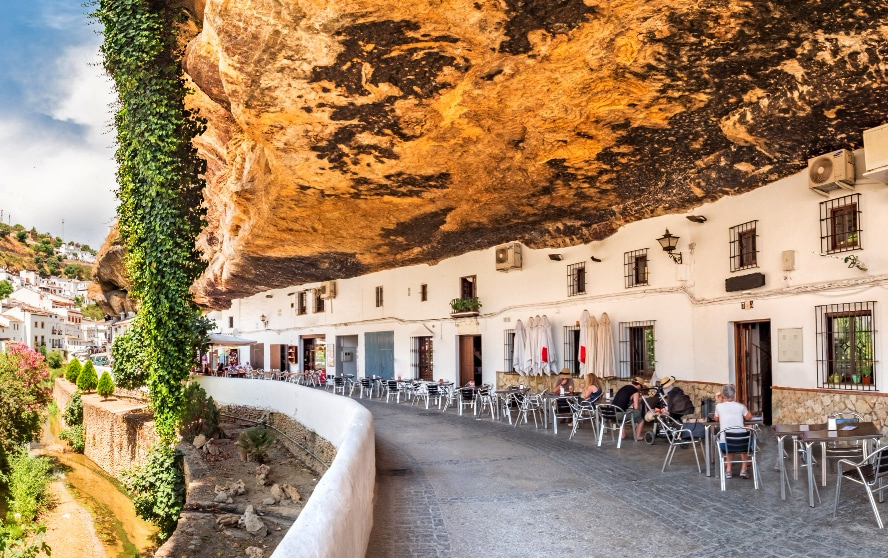
In the Andalusian province of Cadiz, Setenil de las Bodegas is a spectacular little town of about 3000 inhabitants, literally embedded in the river Guadalporcun canyon. Differently from the other Pueblos Blancos of Andalusia, built on hills or cliffs, Setenil houses are built inside and under the rocky walls of the canyon. The charm of this village derives from the rustic beauty of its architecture and the originality of its urban frame. With a high slope the town descends from the Castle, adapting to the course of the river. Parallel to the river are its famous cave streets: Cuevas del Sol, Cuevas de la Sombra and Cuevas San Roman. Setenil is also famous for its meat products, particularly chorizo from pigs raised in the surrounding hills and for its fine pastries, bars and restaurants which are among the best in the region.
Seville by Bus and on Foot
Morning
- Guided tour:
- Panoramic bus ride for an introduction to the most important sites in the city.
- Royal Alcázar. Discover the hidden corners of the oldest European fortified palace still in use today, a marriage of Christian and Mudéjar architecture.
- Plaza de España, the formidable and most famous square in Seville built inside the Maria Luisa Park in 1928 for the Ibero-American Exposition of 1929.
Afternoon
- Free time or optional activities:
- The Metropol Parasol, popularly known as the Las Setas de Sevilla (The Mushrooms), is the largest wooden structure in the world, made up of six large interconnected parasols in the shape of mushrooms. The walkway and viewing point, accessible with the elevator, offers fantastic views of the city.
- Perhaps a controversial subject, but the Plaza de toros de la Real Maestranza, is the most legendary bullring in the history of bullfighting and the third most visited monument in Seville. The building, with its Baroque façade, its harmonious proportions and its tradition is without doubt the most beautiful and suggestive in Spain.
- Museo del Baile Flamenco, an 18th century building that houses the museum of flamenco dancing history & culture.
- Casa de Pilatos, an example of an Italian Renaissance building with Mudéjar elements and decorations. It is considered the prototype of the Andalusian palace.
- Iglesia Colegial del Divino Salvador, the second-largest church in Seville after the city's cathedral.
Real Alcázar
The Royal Alcázar of Seville is Europe’s oldest palace in use and a preeminent example of Mudéjar style in Spain. In the 11th century the Abbadid king ordered its construction in a strategic area of the town, after the Spanish Reconquista in the 13th century, the Alcázar was converted into the residence of the Catholic monarchs and remodeled with Gothic and Renaissance elements. Of major interest are the sumptuous Mudejar Palace built by king Pedro I, the Gothic Palace of king Alfonso X, and the Ambassadors Hall (the ancient throne room), where Islamic decoration and ornamentation were widely used by the mudejar artisans. In the 16th century Charles V restored the Patio de las doncellas (Courtyard of the Maidens), famous for its gallery of precious arabesques. The Puerta del León, the main entrance to the Alcázar, takes its name from the 19th century tile-work inlaid above it, a crowned lion holding a cross in its claws and bearing a Gothic script.
Plaza de España
The spectacular Plaza was built for the Ibero-American Exposition of 1929. The shape is a huge semicircle surrounded by a building designed by the architect Aníbal González, who mixed elements of the Baroque, Renaissance and Moorish revival to represent the different architectural styles of Spain. The building is enlivened by a portico, a first floor balustrade and balconies stretching along its length. In front of the building, following the curve of the façade, is a moat crossed by four bridges representing the four ancient kingdoms of Spain, while the two tall towers at either end of the building are a landmark of the city. In the 52 alcoves all around the Plaza, the mosaic tiles depicting the 52 Spanish provinces are a celebration of the world renowned andalusian art of azulejos.
The Heart of Seville
Morning
- Guided tour:
- Cathedral, the biggest and most spectacular church in Spain, a gothic masterpiece and home of the remains of Christopher Columbus. From the top of the Giralda bell tower, formerly a minaret, the view of the city is astonishing.
- Barrio de Santa Cruz, the most picturesque and delightful part of the city, a labyrinth of narrow cobbled streets with alleys and vibrant and colorful buildings.
Afternoon
- Free time or optional activities listed on the previous day (DAY 11).
Catedral de Santa María de la Sede
After the Reconquista of Seville (1248), the Almohad Mosque was immediately christianised, but it wasn’t until 1401 that the decision was taken to erase it from history and build a Christian church on its site. Today, the only parts that have survived of Seville’s Great Mosque are the Giralda bell tower, the Patio de Naranjas and the Puerta del Perdón. The gigantic Cathedral was intended as a display not only of the prestige and wealth of Seville, but also of the triumph of Christianity over Islam, therefore the construction was a costly, long and laborious process that lasted more than a century. The Giralda was originally built in 1195 as the minaret of the Mosque, while the Renaissance-style belfry was added in the 16th century. Registered as a World Heritage site by UNESCO, the Giralda remains one of the most important symbols of the city, as it has been since the Middle Ages.
Barrio de Santa Cruz
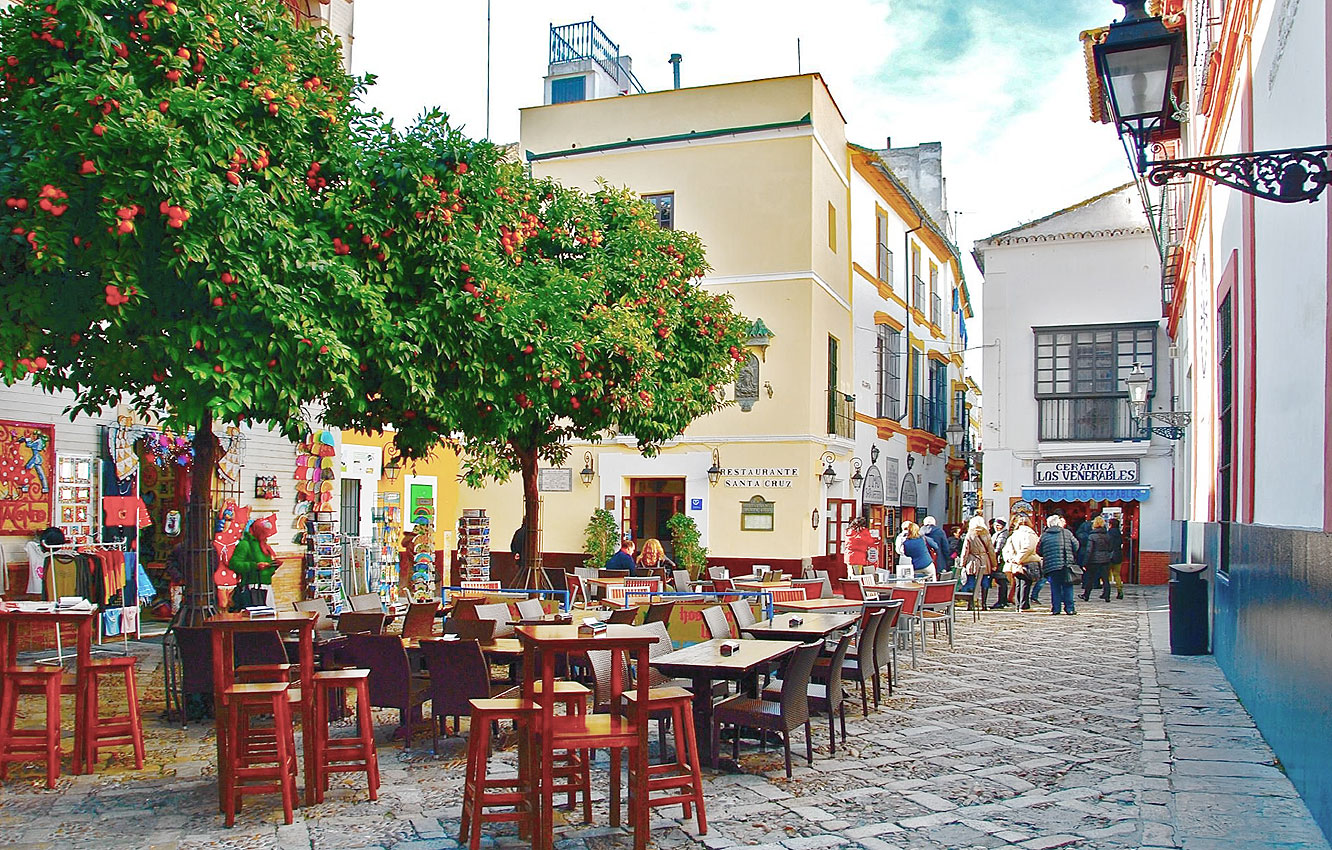
The Barrio of Santa Cruz is the most romantic corner of Seville. Located in the old Juderia (Jewish quarter), its cobbled narrow streets and alleys are flanked by little white houses and patios finely decorated with azulejos (from the arab al-zulay, little stone). One of the largest streets of the Barrio is the vibrant Calle Mateos Gago, while the narrow Callejón del Agua (Water Alley) was originally the camino de ronda (wall walk) of the Alcázar. In a picturesque house of this Callejón, today house number 2, stayed the American writer Washington Irving in the year 1828. In the very heart of the Barrio are the Plaza of Santa Cruz and the baroque Hospital de los Venerables, built in the 17th century, today the Velázquez Centre.
7th Leg: Moving to Cáceres
A Little of Everything
Morning
- Meet at 9:30 to leave for Cáceres in Extremadura, a little known and off the beaten path rural region of the Iberian Peninsula.
- Stop at a farm that raises pigs and produces Iberian Ham. Walk to the meadow where the pigs live in their natural environment and then visit the drying house where hams are aged.
Afternoon
- Drive to Aracena to visit the Gruta de las Maravillas (the Cave of Wonders), a network of limestone caverns located in the center of the town.
- Drive to Mérida to visit the b. Well preserved, it is considered to be one of the 12 Treasures of Spain and, together with the Segovia Aqueduct, one of the best preserved Roman monuments in Spain.
- Drive to Cáceres.
Dinner with a view on the Plaza Mayor.
Cáceres
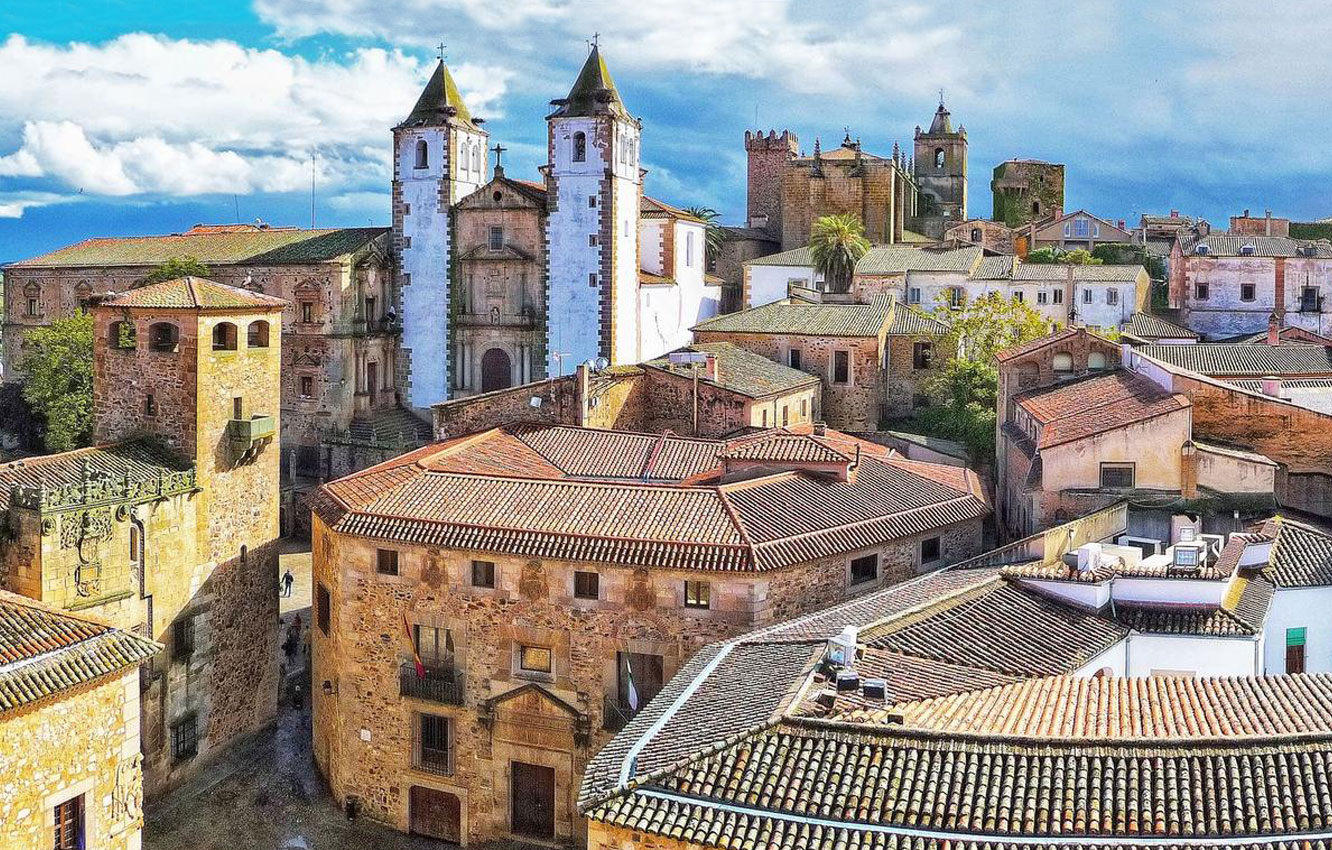
Located in Estremadura, Cáceres has been an important trade route city for many centuries. Its strong historical roots were shaped first by Roman settlers, then by Muslim, Jewish and Christian people. The remains of these different cultures can be observed in the walled ensemble, where fortress houses, palace houses and towers of the Gothic and Renaissance times dominate the city's spatial configuration. Thirty towers from the Islamic period still stand in Cáceres, among which the Torre de Bujaco (12th century) is the most famous. The Plaza Mayor, originally a large market place outside the walls, is the center of the Historic Quarter and gateway to the Monumental City, while the Old Jewish Quarter preserves the layout of the typical narrow streets of the Islamic and Jewish period. Cáceres was declared a World Heritage City by UNESCO in 1986.
Jamón Ibérico
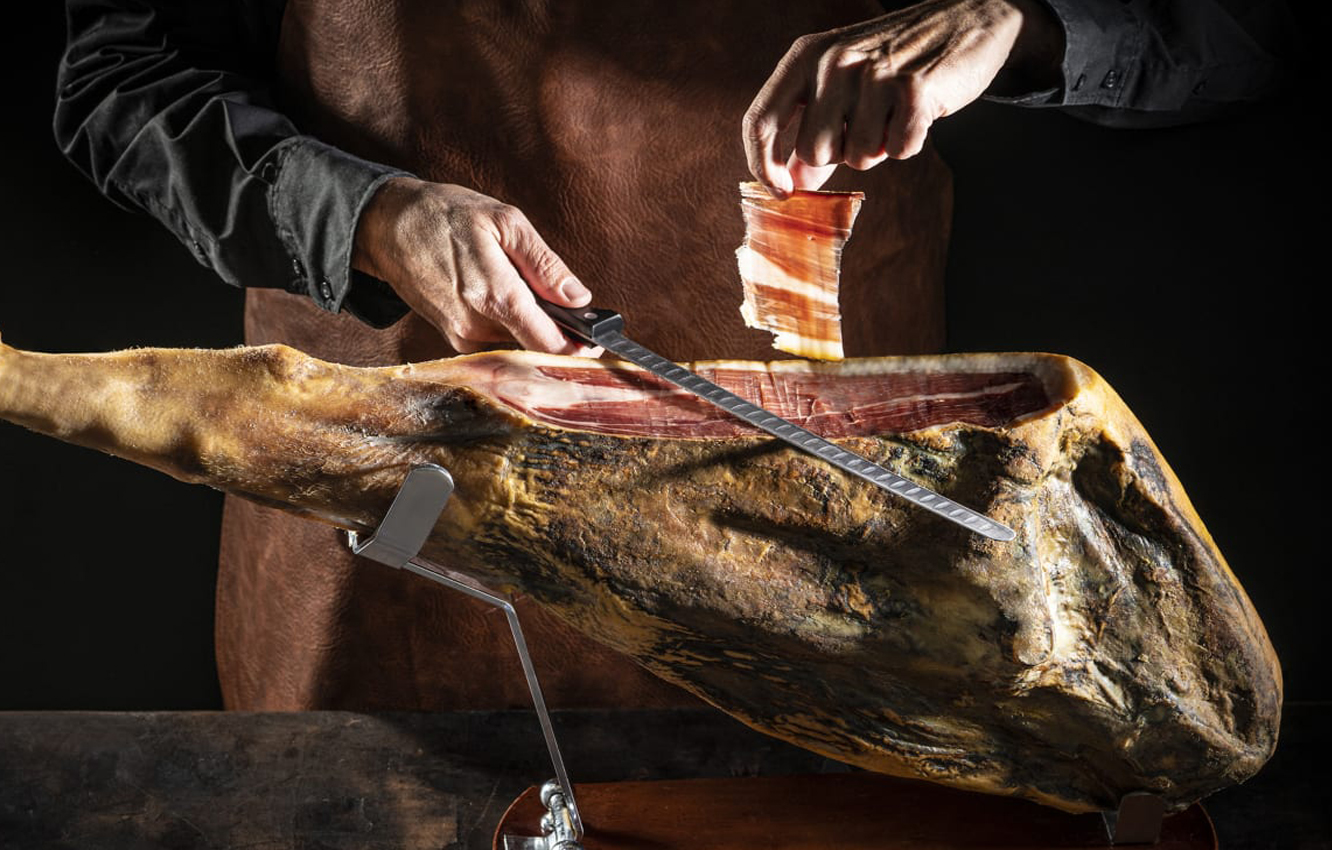
The historical area of production of the pure Iberian breed is 4 million hectares (15444 mi2), occupying a large part of the western and south-western Iberian peninsula. Based on the diet, type of pig farms and aging, from 14 to 48 months, the Iberian ham is labeled in three different ways; Jamón Ibérico de cebo (feed) when the pigs were fed both with bran and natural products in the stable. The Jamón Ibérico de cebo de campo (pasture) includes a portion of acorns in the diet, plus the animal has spent its life in the open air. Finally the Jamón Ibérico de bellota (acorn) also called “Pata Negra” (black hoof), famous because the pigs feed only on natural foods and acorns and live in the wild.
Aracena – Gruta de las Maravillas

Aracena is a town and municipality in the province of Huelva, south-western Spain. One of its prominent attractions is the Gruta de las Maravillas. The entrance to one of the most spectacular caves in Spain is right in the middle of the town, below the hill on which stands the Aracena Castle. With a 2130 m (6988 ft) of trail, the Grotto is an amazing underground space because of its length, its crystal-clear lagoons and the wide variety of rock formations. The first reference to the cave dates from 1850. It was opened to the public in 1914 and became one of the first tourist caves in Spain. Due to the water, the stone labyrinths of the Grotto have formed stalactites, stalagmites, columns, flowstones, mountain passes and curtain formations that create a variety of beautiful rooms.
Teatro Romano De Mérida
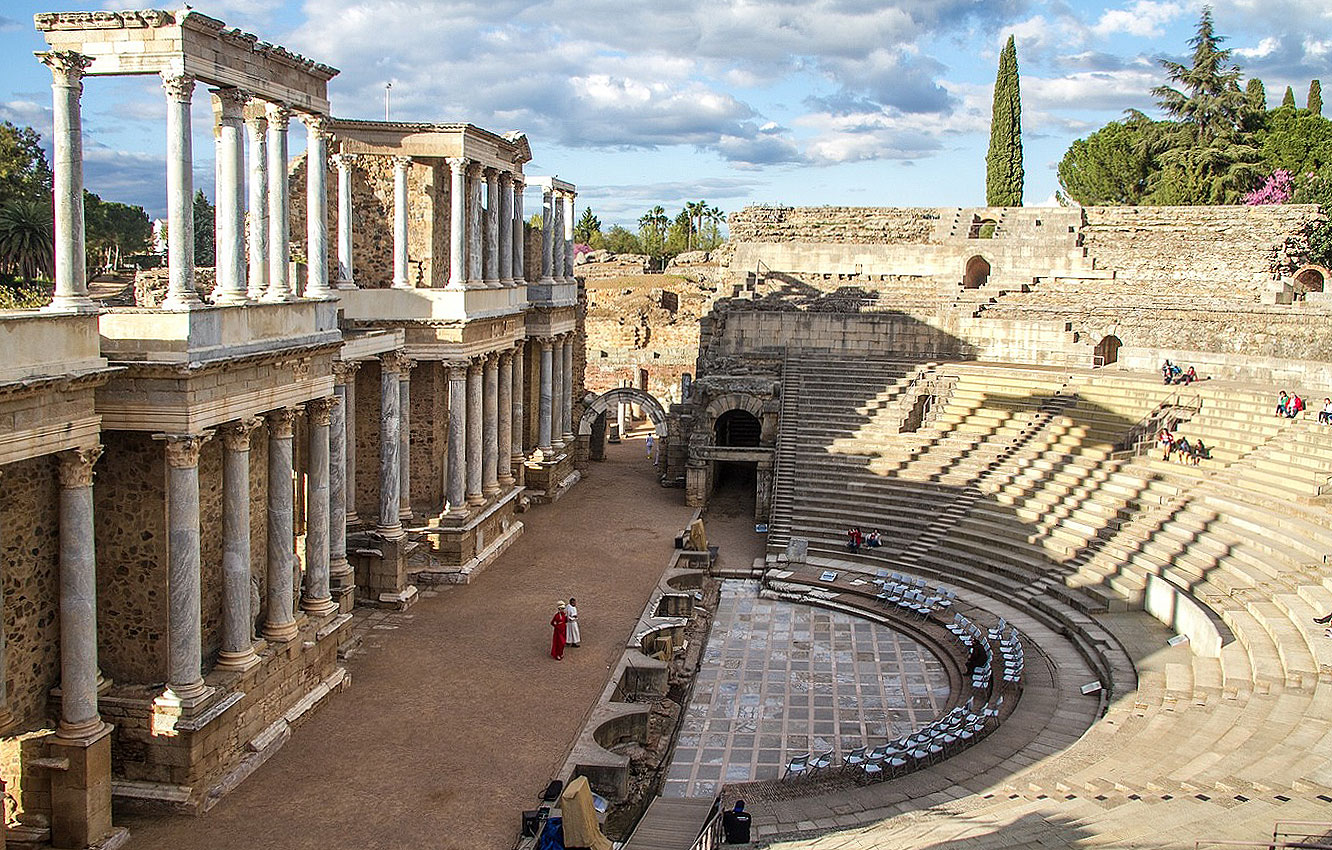
The Roman theater of Mérida dates back to the years 16 to 15 B.C. It was built as part of an entertainment complex together with the Amphitheater. Both are now part of the Archaeological Ensemble of Mérida, one of the most important archaeological sites in Spain. The theater corresponds to the model with a grandstands cavea of a semicircular shape that had a seating capacity of 6.000, and an orchestra in a semicircular space paved with white and blue marble. With its length of 63 m (206 ft) and 17.5 m (57 ft) in total height, the portico behind the stage is its most spectacular feature. Upon a base of red marble stones stand Corinthian columns with blue-veined marble. The columns support an entablature with architrave and richly decorated friezes and cornices. The theater has been a UNESCO World Heritage Site since 1993.
The Storks, Birds of Cáceres
Morning
- Guided tour through the historic center of Cáceres, to discover a super monumental city, full of palaces, watchtowers, royal temples, fascinating squares and the storks that for many years have embellished the city with their nests atop the towers and chimneys.
Afternoon
- Drive to Trujillo, one of the best preserved medieval cities in Spain, where the conquistador Francisco Pizarro was born. The Plaza Mayor, with its sumptuous Renaissance houses and a variety of sacred art, is an example of the greatness of the city.
- Drive back to Cáceres.

Situated on a hill 40 km (25 mi) east of Cáceres, the picturesque city of Trujillo (Turgalium in Roman times) was a town of importance in the European Middle Ages. Francisco Pizarro, conqueror of Peru, was born here in 1478. His palace still stands, and his tomb is in the Church of Santa María de la Concepción. The town also has Roman remains, and an impressive Moorish castle. In the 16th century explorers from Trujillo, called Trujillanos, crossed the Atlantic Ocean to the Western Hemisphere. On their return, majestic palaces near the Plaza Mayor were built. Among them, of great historical importance is the Palace of the Conquest, built by the heir of Francisco Pizarro. Other important monuments are the Alcazaba (Moorish castle), the church of Santiago, the church of Santa María la Mayor, the church of San Francisco, and the Church of San Martín.
8th Leg: Moving to Cáceres
On the Way to Segovia
Morning
- Meet at 10:00 to leave for Segovia.
- Stop in Plasencia. The town has an important historic quarter and is located in a strategic point along the Ruta de la Plata (Silver Route), an ancient commercial and pilgrimage path that crosses the west of Spain from north to south, connecting Mérida to Astorga.
Afternoon
- Drive to Segovia.
- Aperitif overlooking the Cathedral.
Plasencia
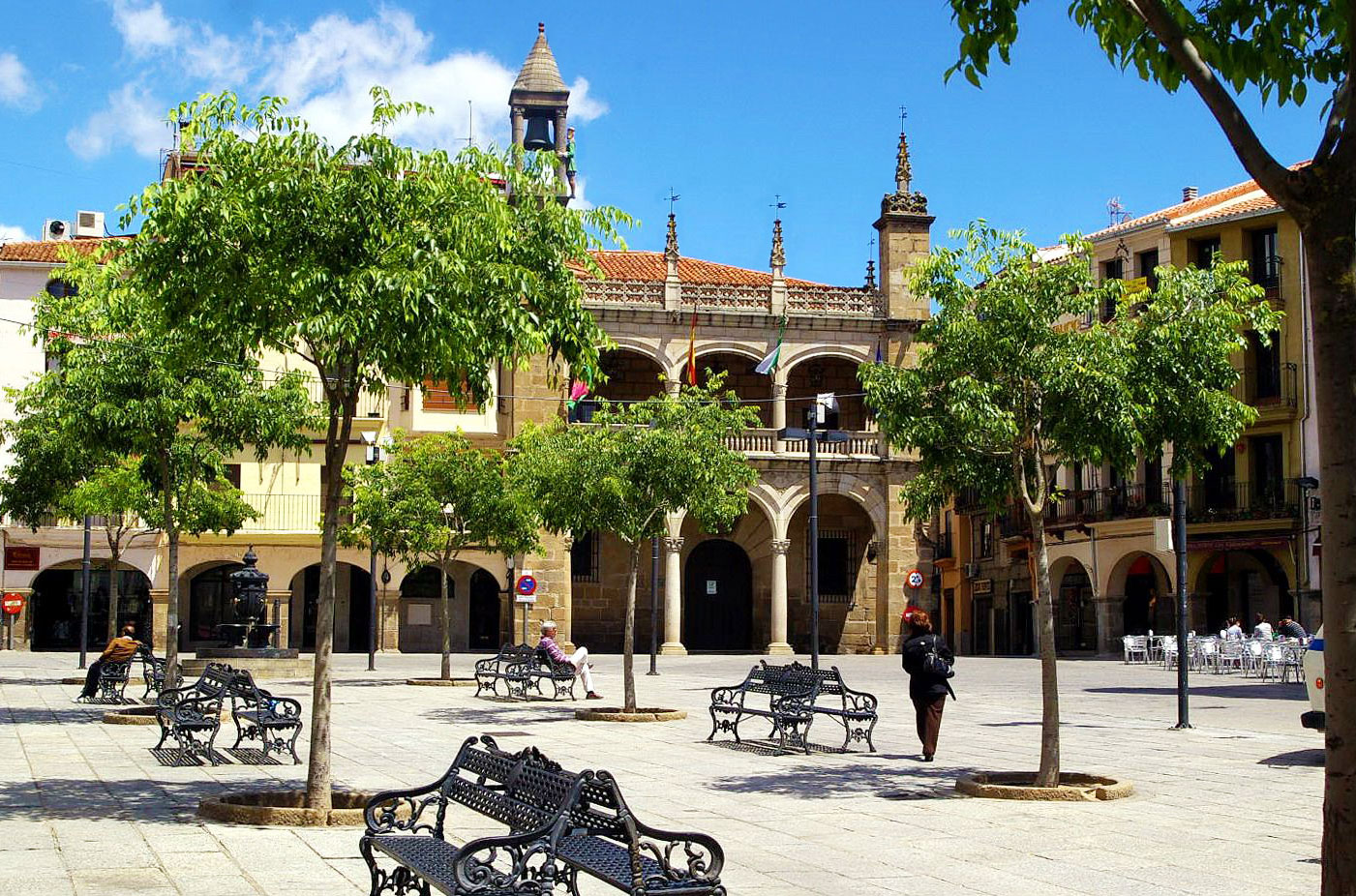
Before Plasencia was founded in 1186 by King Alfonso VIII of Castile, it had already been a Roman settlement and later it was conquered by the Moors due to its strategic location. At the end of the 13th century the king granted the Charter of Plasencia, which allowed the peaceful coexistence between Christians, Muslims and Jews. This led to the formation of an important Jewish community, the largest in Extremadura and a considerable economic power. King Ferdinand the Catholic moved here in 1515 when the court doctors recommended Plasencia as the healthiest place to live in all of his kingdom. Known as the “Pearl of the Jerte valley”, Plasencia, where Nature and Culture go hand in hand, is a city that is of great cultural and historic interest as the other Extremaduran cities but that adds its urban beautiful parks to its legacy.
The City With a Fairy-tale Castle
Morning
- Walking guided tour:
- Roman Aqueduct, an outstanding civil engineering feat due to its monumentality, its excellent state of conservation, and in particular, its stunning location in relation to the urban site.
- Alcázar, one of Spain's most impressive castles, rising out of a rocky crag, stands prominently with 360 degree views, overlooking the valleys below. Its impressive silhouette is one of the inspirations for the Walt Disney Cinderella's Castle.
- Catedral, also known by many as “The Lady of Cathedrals”, due to its size and slenderness.
Afternoon
- Free time or optional activities:
- Real Casa de la Moneda (Royal Mint), one of the oldest commercial buildings in Spain, built in the 6th century. These days, the mint is a museum about the history of money, how it was made, and the different tools and machines used. The mint used a water wheel to generate hydraulic power coming from the Eresma River, still standing and fully functional today.
- Iglesia de la Vera Cruz, a church just outside the city where the surrounding landscape becomes picturesque, with small roads and rolling green hills. It is a beautiful church from the 13th century founded by the Knights Templar and inspired by the original Temple of the Knights in Jerusalem. The inside is rather simple but leaves visitors with a sense of wonder about what mysteries the walls hold from times long gone.
- Drive to San Ildefonso to visit the Palacio Real de la Granja or more simply known as La Granja, a Royal Palace built in the early 18th century in the small town of San Ildefonso. The sumptuous rooms and the magnificent sculptural fountains made in sober Baroque style, and the 360 acres of surrounding land and landscaped Versailles-like gardens make the Palace a testimony of the glory of the Spanish Monarchy.
- Puerta de San Andrés, one of the city gates with access to the wall’s walkway. The views over the Jewish quarter are stunning.
- La Judería. Stroll through the characteristic streets of the Jewish quarter, a second heart of the city.
- Time to do some washing at a laundromat.
Segovia
Segovia is located in the autonomous community of Castilla y León, the capital and most populated municipality of the homonymous province. The celtiberian town was conquered by the Romans between 98 and 94 B.C. In 1088, after the Arab abandoned it, Segovia was repopulated by King Alfonso VI. In medieval times, prosperity and a position of some importance came when it became a royal residence during the reign of king Alfonso X. Queen Isabella was crowned there in 1474. In the 16th century the city experienced a major industrial growth owing to the fabrication of woolen cloth. There are two well-differentiated areas in Segovia: an upper town encircled by ancient walls, situated on the narrow ridge between two small rivers, and a lower part outside the walls. The center of the old town is the Plaza Mayor, site of the Gothic cathedral. The city's main landmarks are the Roman Aqueduct, the Cathedral and the fairytale Castle, the Alcázar de Segovia. Segovia was registered as a UNESCO World Heritage site in 1985.
Acueducto Romano
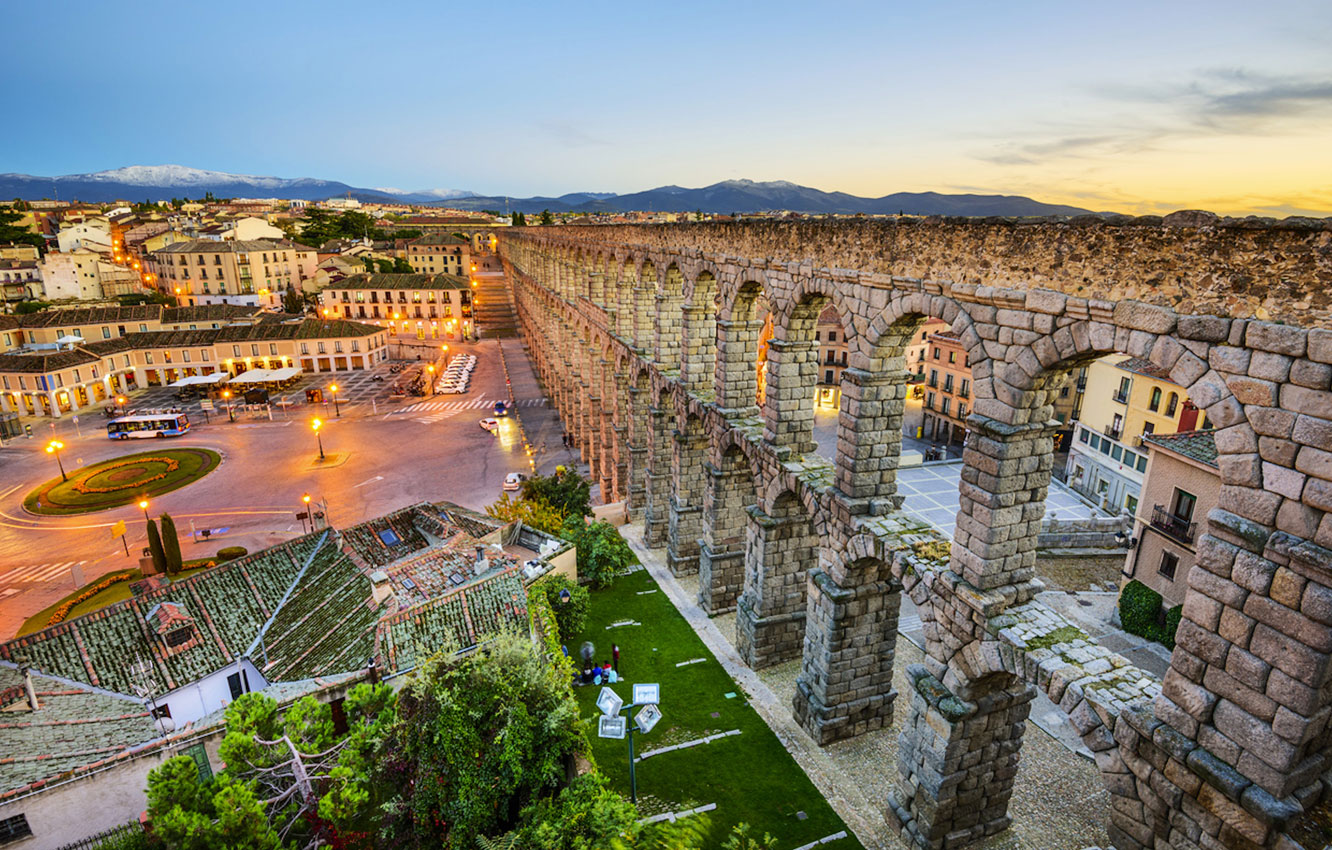
The aqueduct, the city's most important architectural landmark, is one of the best-preserved elevated Roman aqueducts. Kept functioning throughout the centuries, the aqueduct transported water from the Rio Frio river to Segovia until the mid 19th century. Probably built around 50 AD, this impressive construction, with its two tiers of arches is, at its maximum height, 28.5 m tall (93.5 ft). The pillars and arches are made of huge, solid blocks of stone fitting together with no mortar. It is the symbol of Segovia, present on the city's coat of arms.
Alcázar

The word Alcázar comes from the Arabic al-qaṣr, a type of Islamic castle or palace. The Segovia Alcázar is one of Spain’s most visited monuments, built as a Roman Castro (fortified military camp) between the confluence of the Eresma and Clamores rivers. The current castle was built in the mid 15th century by the monarchs of Castilla y León. Twenty-two kings have passed through its halls that are constructed with barrel vaults and twin windows. In the interior, the architecture of each of the halls and rooms have a mixture of Gothic, Roman and Moorish influence. Currently, the Alcázar houses an Armory Museum and the General Military Archive of Segovia.
Catedral
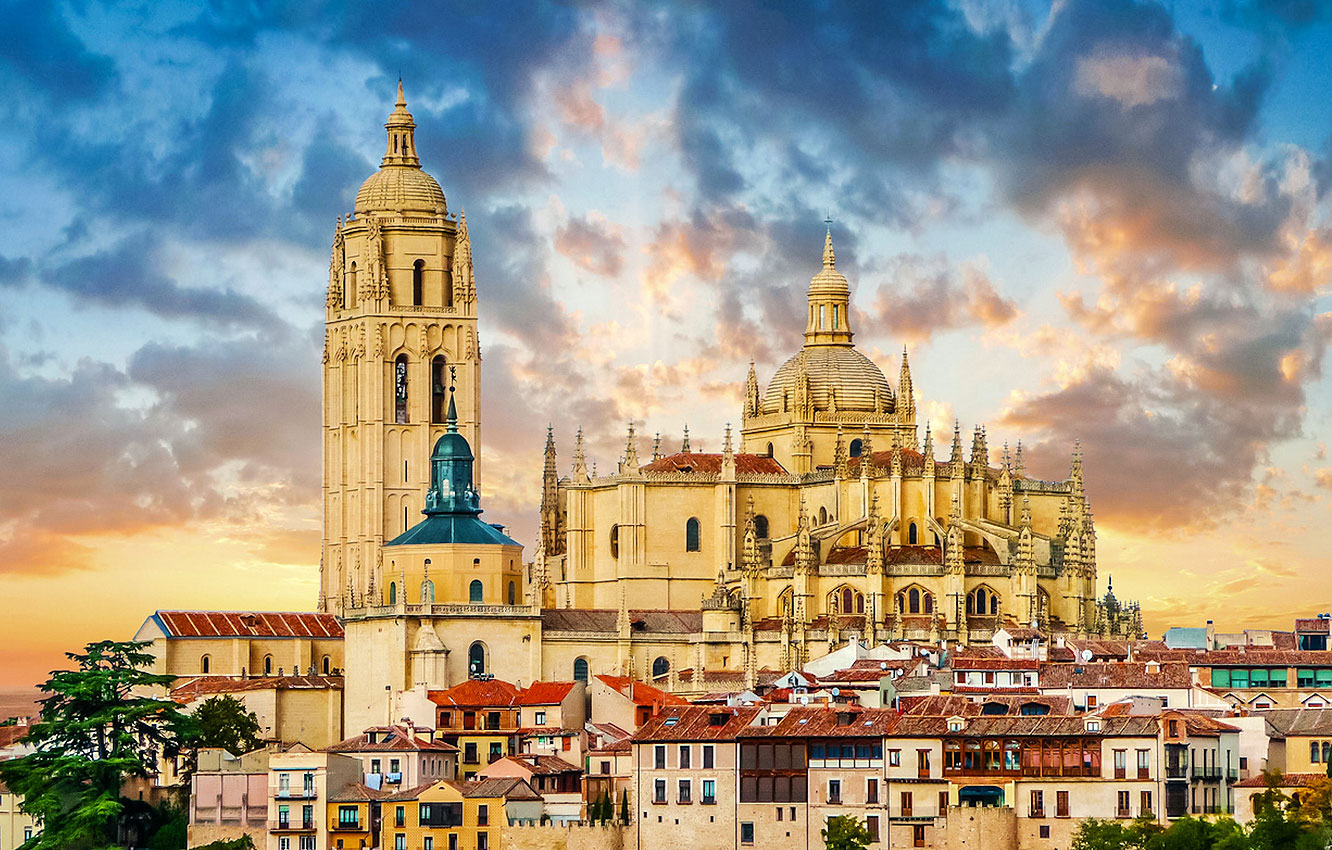
The Cathedral, devoted to the Assumption of the Virgin Mary and San Frutos, located at the highest point of the town in the Plaza Mayor, was built in the late Gothic style after a fire in the old Romanesque church in the year 1520. The first stone of the new Cathedral was placed on the 8th of June 1525 during the reign of Carlos V. The current stone spire crowning the tower was built in 1614 after a fire caused by a thunderstorm destroyed the original one which at the time was entirely Gothic, built of wood and was the tallest tower in Spain.
A Mystic in a Walled City
Morning
- Meet at 8:30 to drive to Ávila, which was home to Teresa de Jesús, a Carmelite nun and prominent Spanish mystic and religious reformer.
- Guided tour through the town and its "Great Wall", a very well preserved medieval wall that completely encloses the city.
Afternoon
- Drive back to Segovia.
- Free time or optional activities listed on the previous day (DAY 16).
Ávila
In the autonomous community of Castile and León, Ávila is the capital and most populated municipality of the homonymous Province. Situated at 1.132 m above sea level, the city is the highest provincial capital in Spain. Called Abila or Abela in Roman times, the city still has a typically Roman plan: rectangular in shape, with its two main streets intersecting at a forum (public square) in the center. The medieval town walls, with a polygonal form and extending 2.500 meters in circumference, were built in the 12th century in Romanesque style and enclosed the whole of ancient Ávila. The city has been called the “finest medieval remnant in Spain” and is an important tourist center. Historic landmarks include the Gothic cathedral (completed between the 13th and 15th century), the Convent of Santo Tomás (1482–93), containing the tombs of Torquemada, the first grand inquisitor of Spain, and of Don Juan, the only son of Ferdinand and Isabella; the Romanesque basilica of San Vicente and the Encarnación convent, built on the site of the house of the mystic Saint Teresa.
Back to Where We Started
Morning
- Meet at 9:30 to leave for Madrid.
- Stop in San Lorenzo de El Escorial to visit the homonym Palace and Monastery located at the foothills of the Sierra de Guadarrama, north of Madrid.
Afternoon
- Drive to Madrid.
- Free time or options listed on DAY 2 page.
El Escorial
The Escorial is a vast building complex and the most important architectural monument of the Spanish Renaissance, consisting of the Royal Monastery, the Basilica, the Palace of Philip II, the Pantheon of the Kings with twenty-six marble sepulchers containing the remains of the kings and queens of the Habsburg and Bourbon dynasties, the Art Gallery and the Library. Conceived by King Philip II, started in 1563, it was finished twenty years later. Sparsely ornamented, El Escorial is austere and resembles more a fortress than a palace. It takes the form of a gigantic quadrangle, which encloses a series of intersecting passageways and courtyards. At each of the four corners is a square tower. Near the center of the complex, and taller than the rest, rise the pointed belfries and round dome of the basilica. An important collection of paintings by Renaissance and baroque artists (Titian, Veronese, Tintoretto, Velásquez and El Greco among others) is the jewel of the complex.
An Inevitable Thing, Like in the Movies: The End
The day of departure has arrived, some of you ready to fly back home and others to continue their holiday to new destinations.
For those who are going to the airport, rides to the airport, are available with a shuttle or with us.
We wish you a good return or a good continuation and we hope to see you soon and remember that following your first tour, you will receive a $200 credit for future trips with Tour With Us!
Home | Tours | Policies | Photos | About Us | Contact Us
CST # 2129817-40
Copyright ©2017 Tour With Us. All rights reserved.
Web Site Design: Landini Design, Inc.
